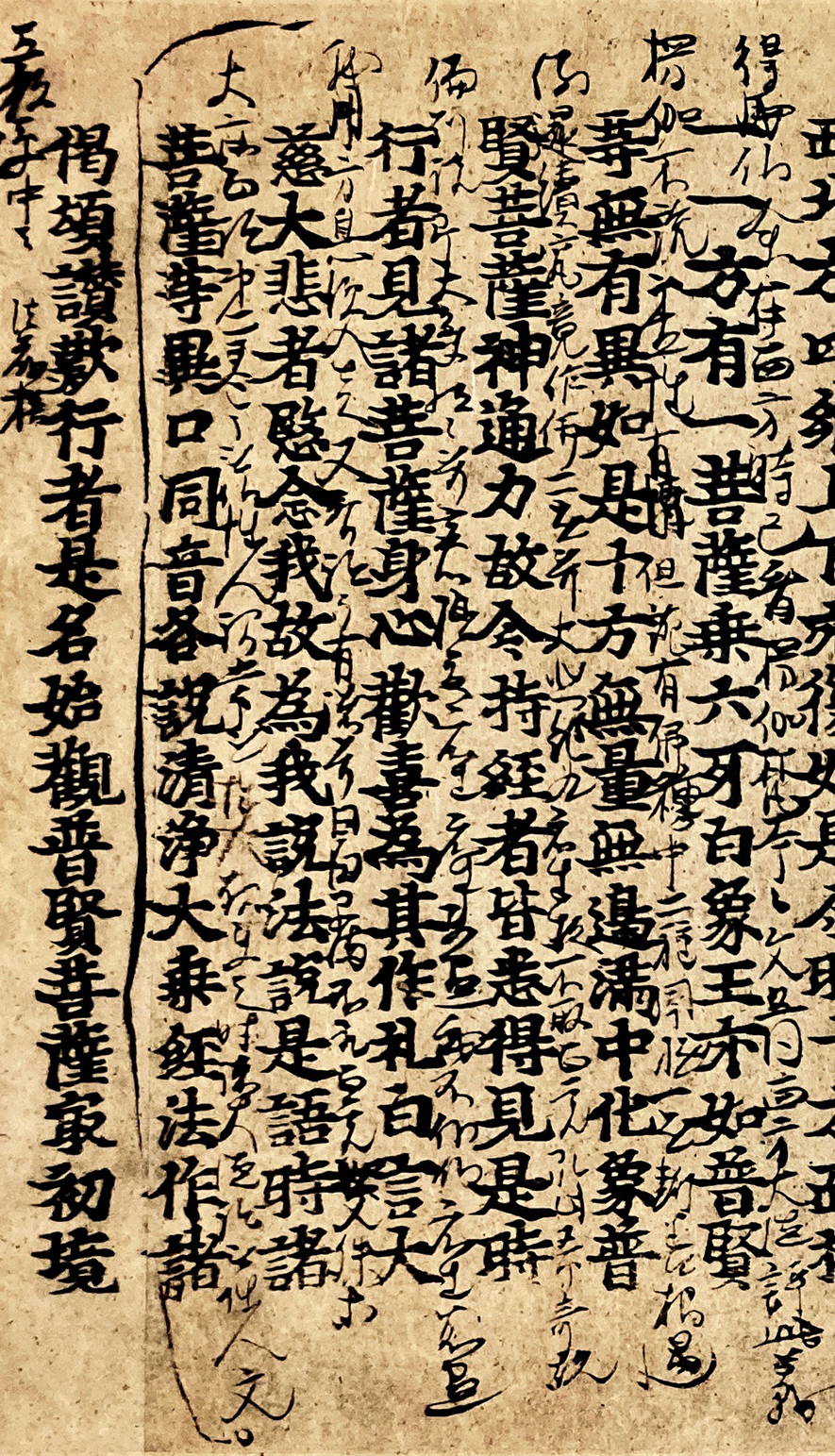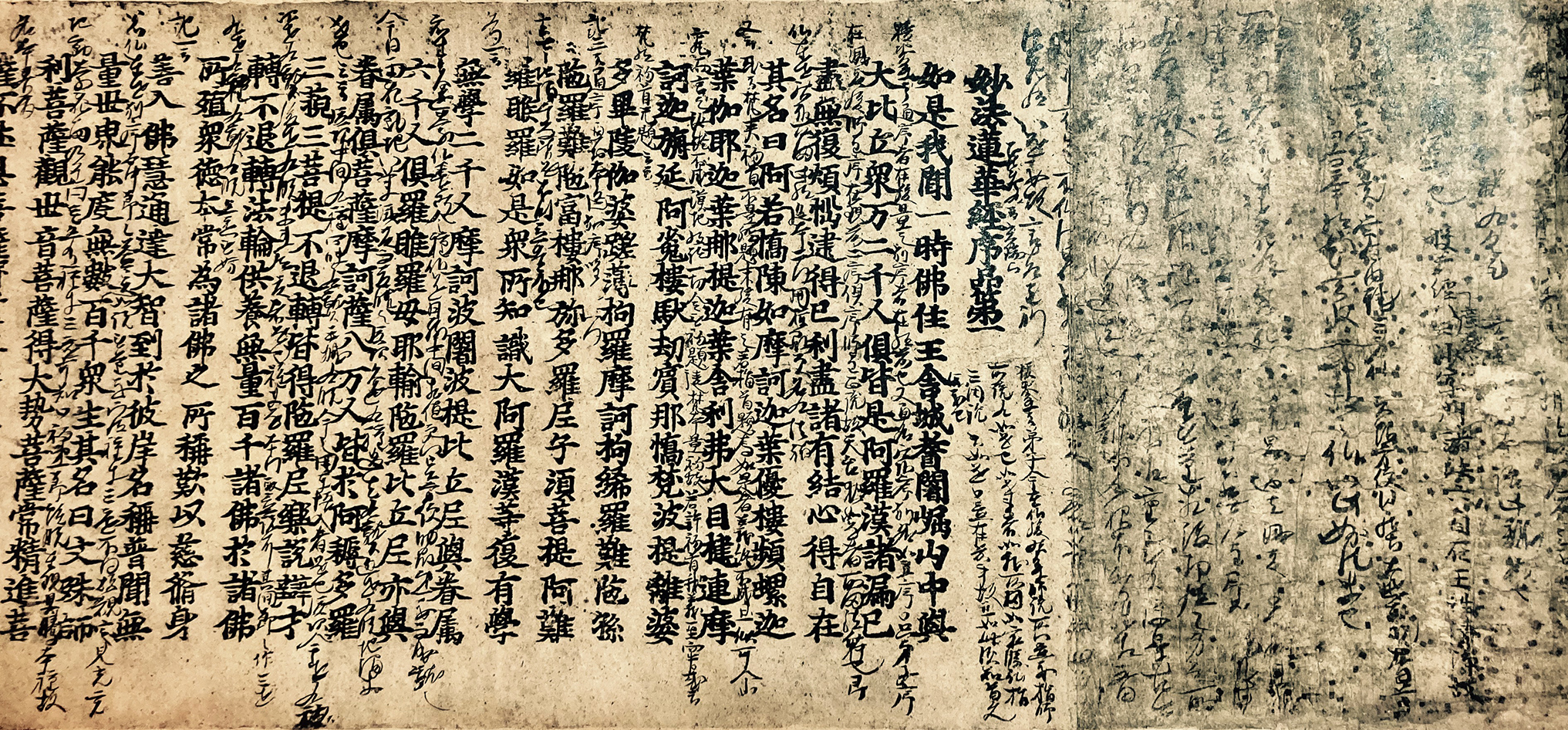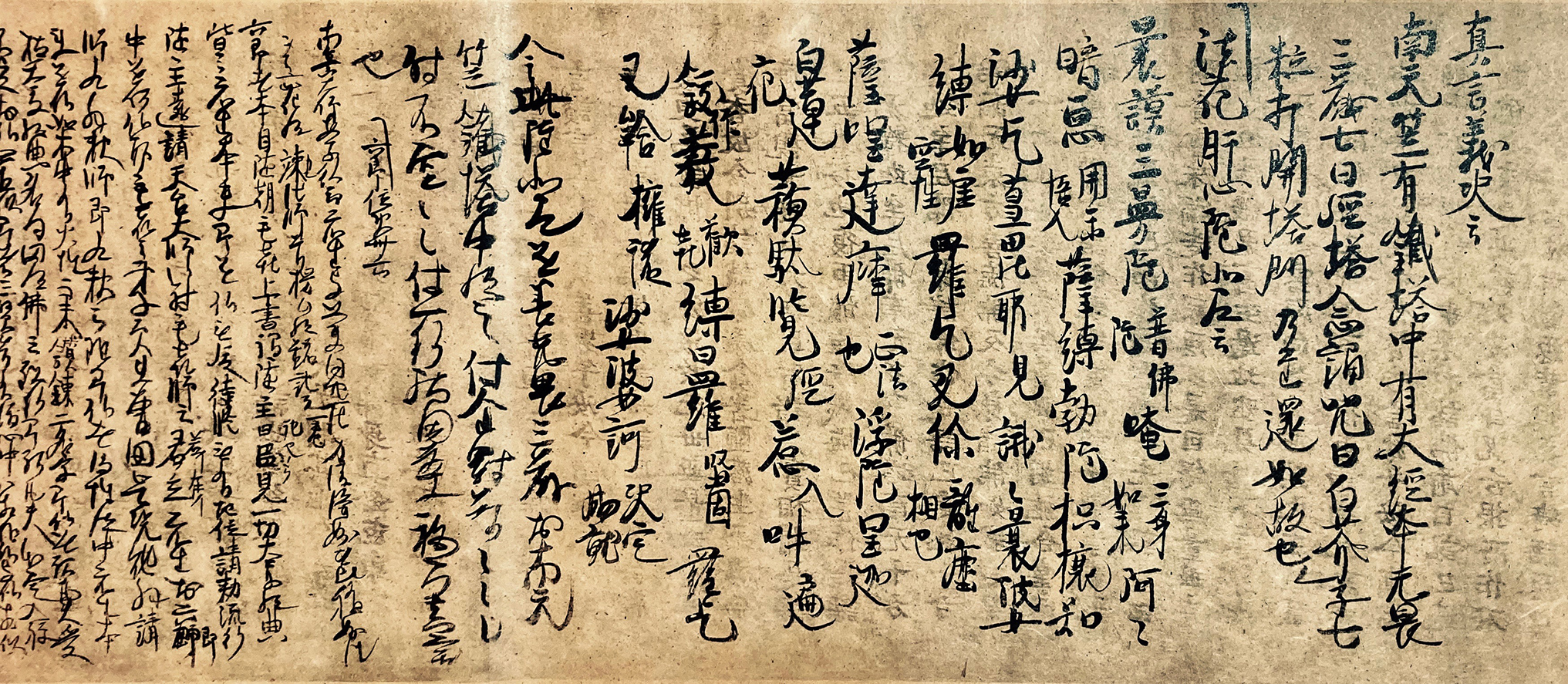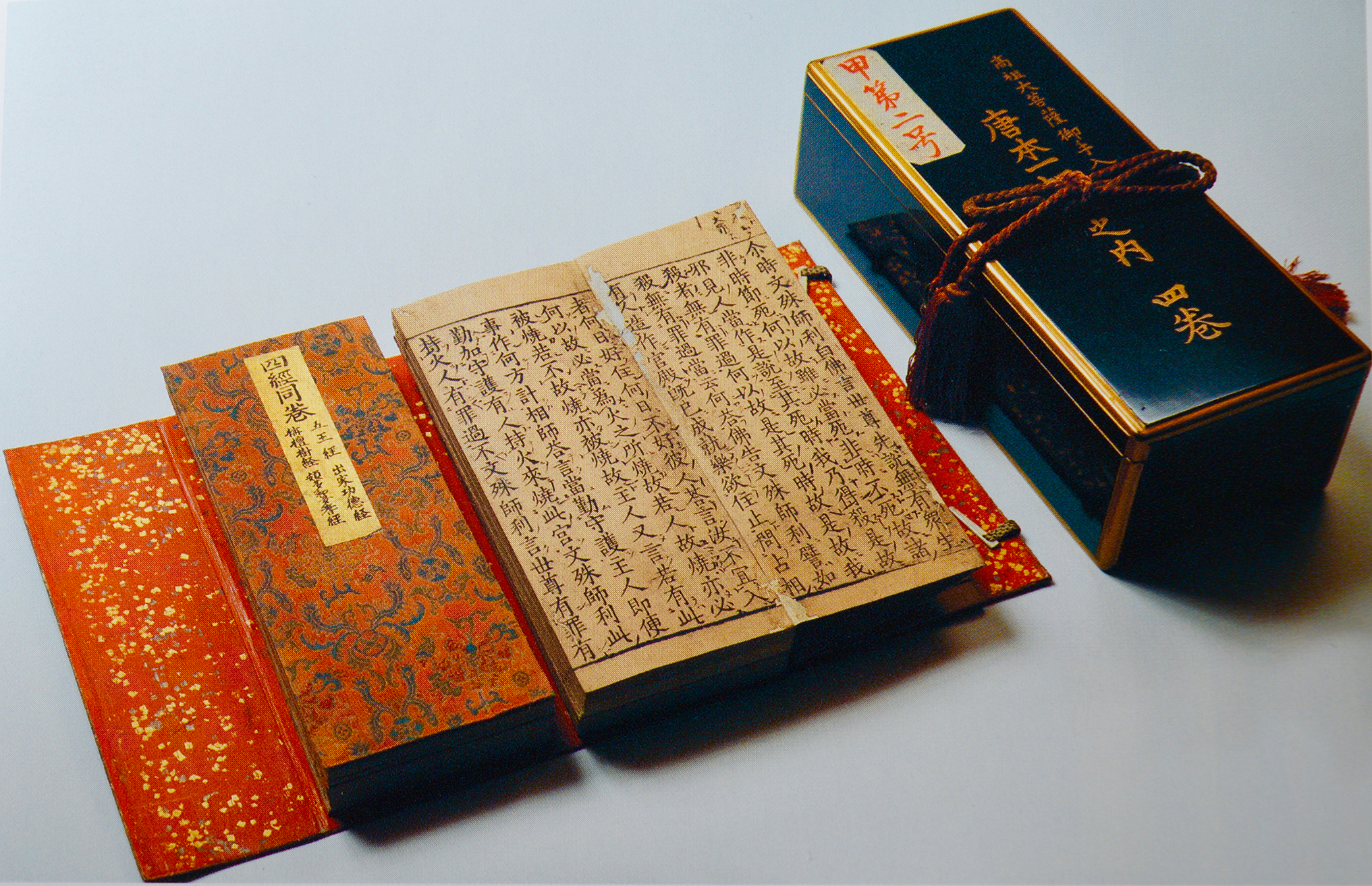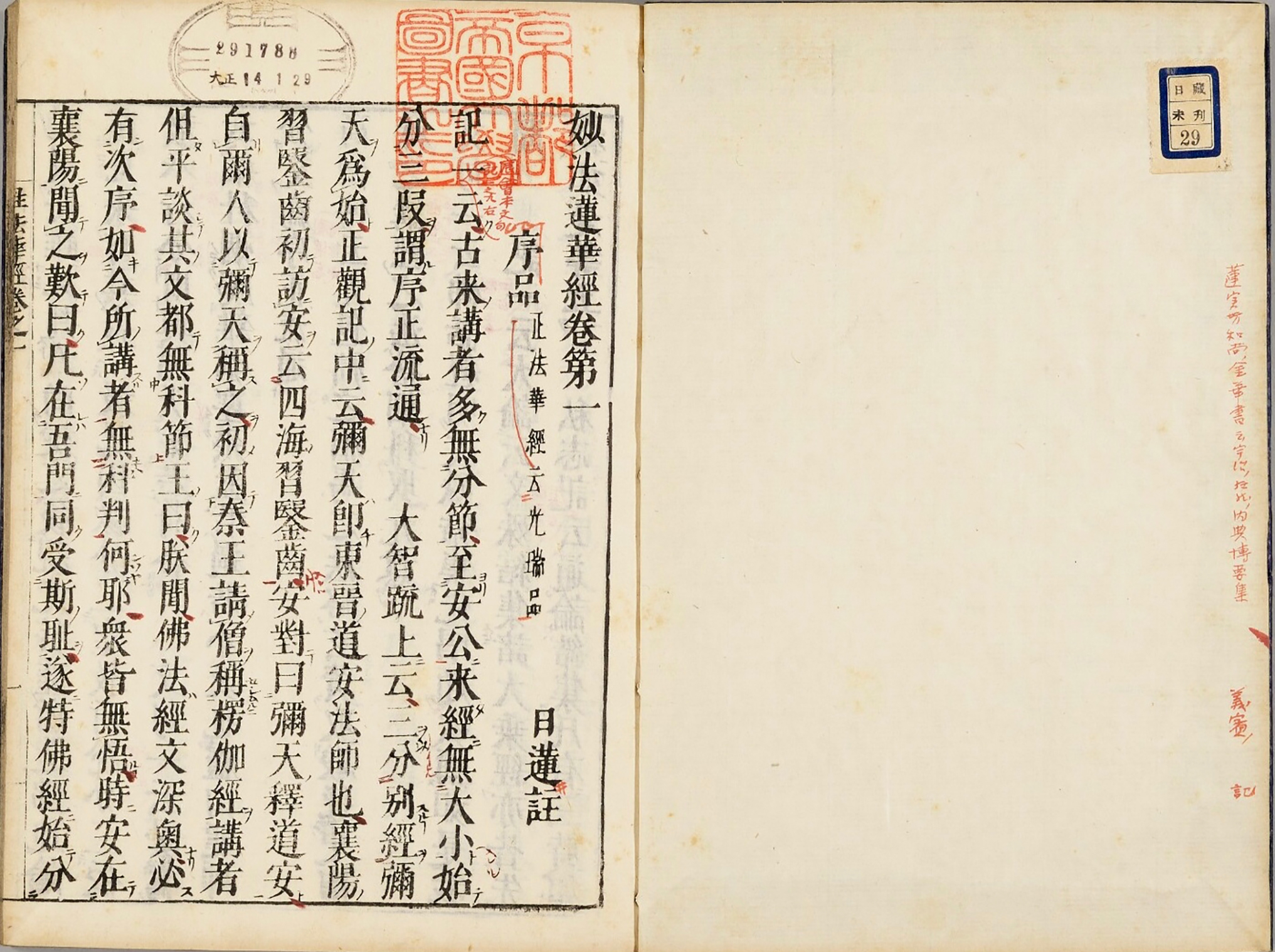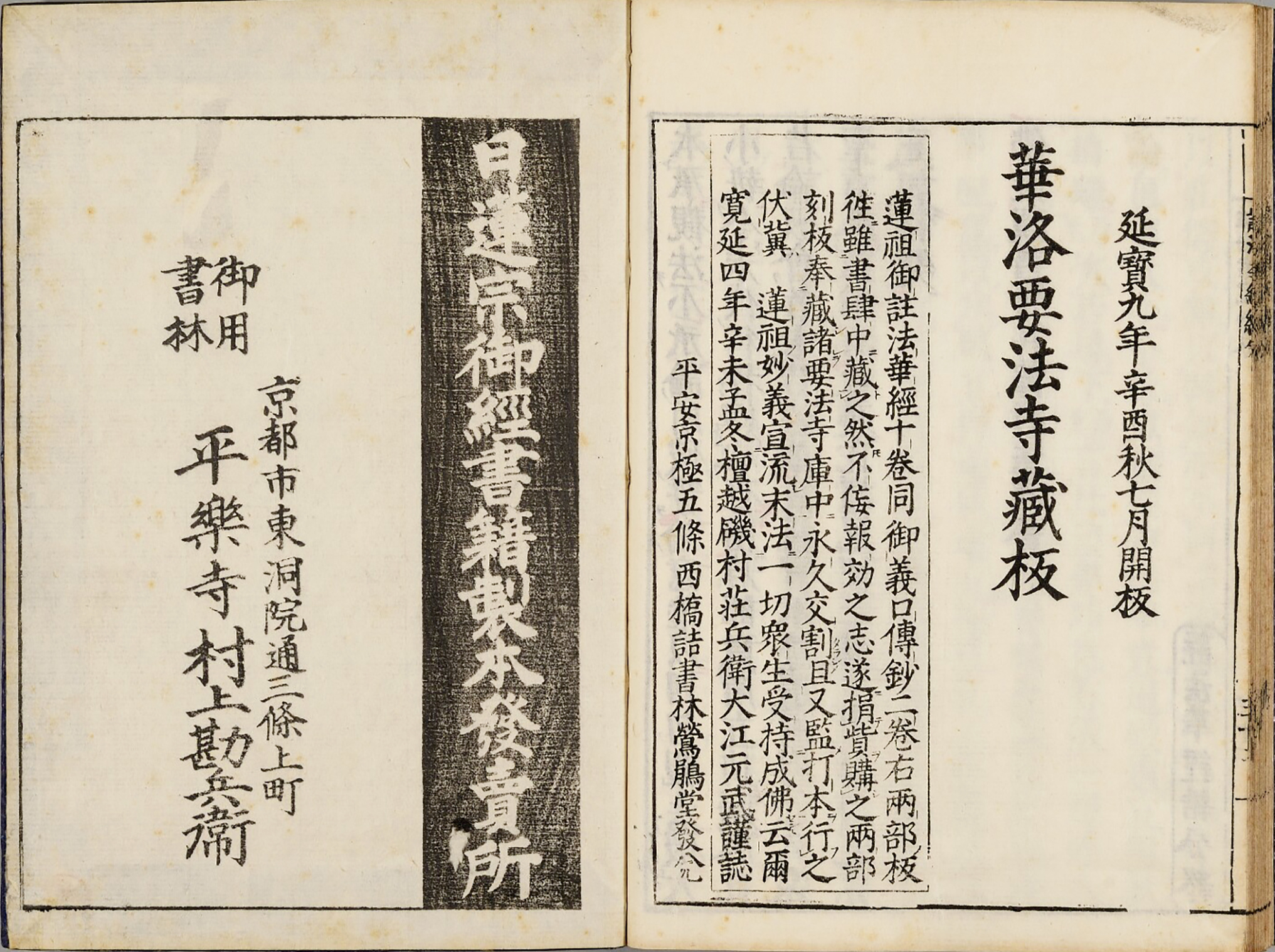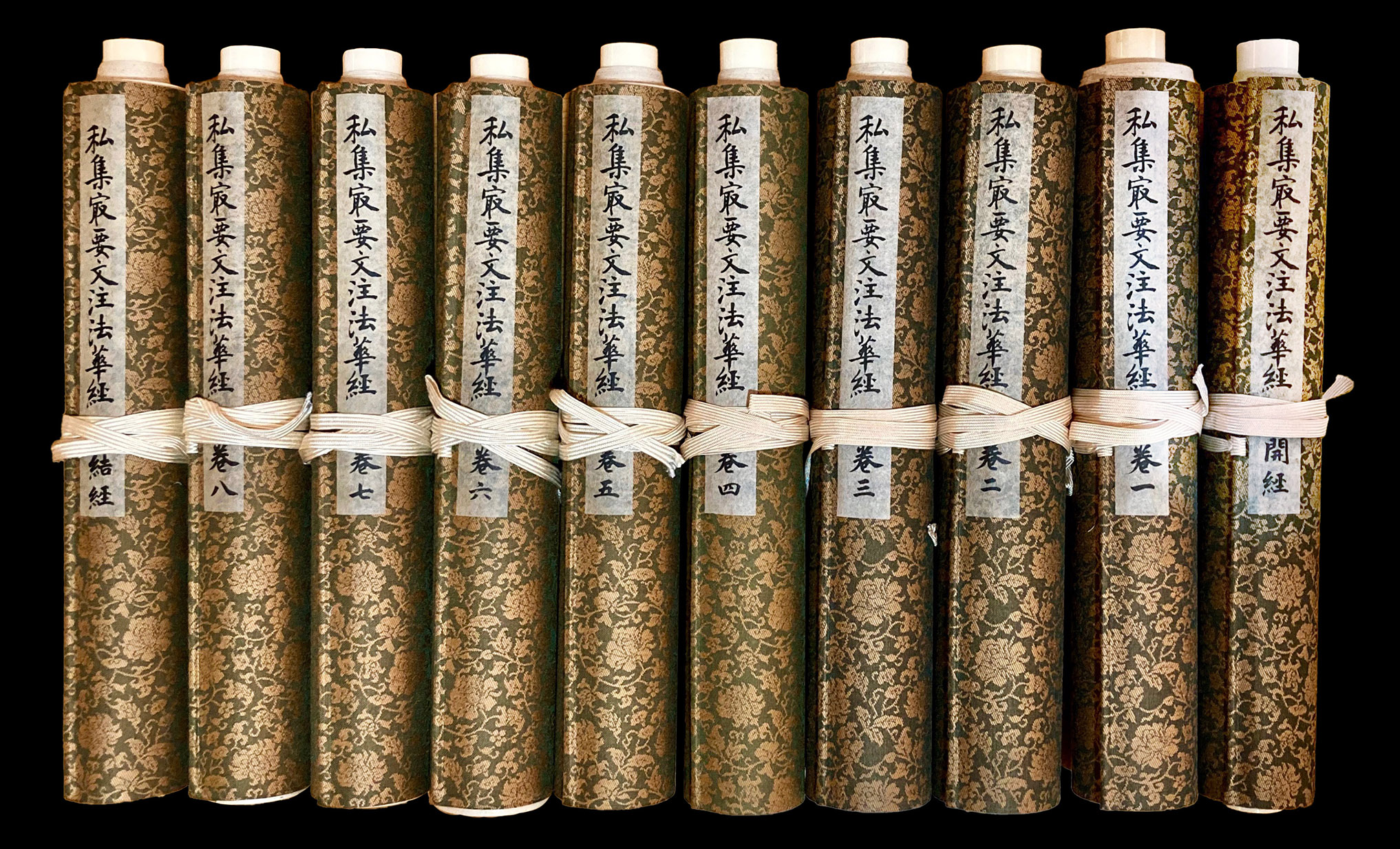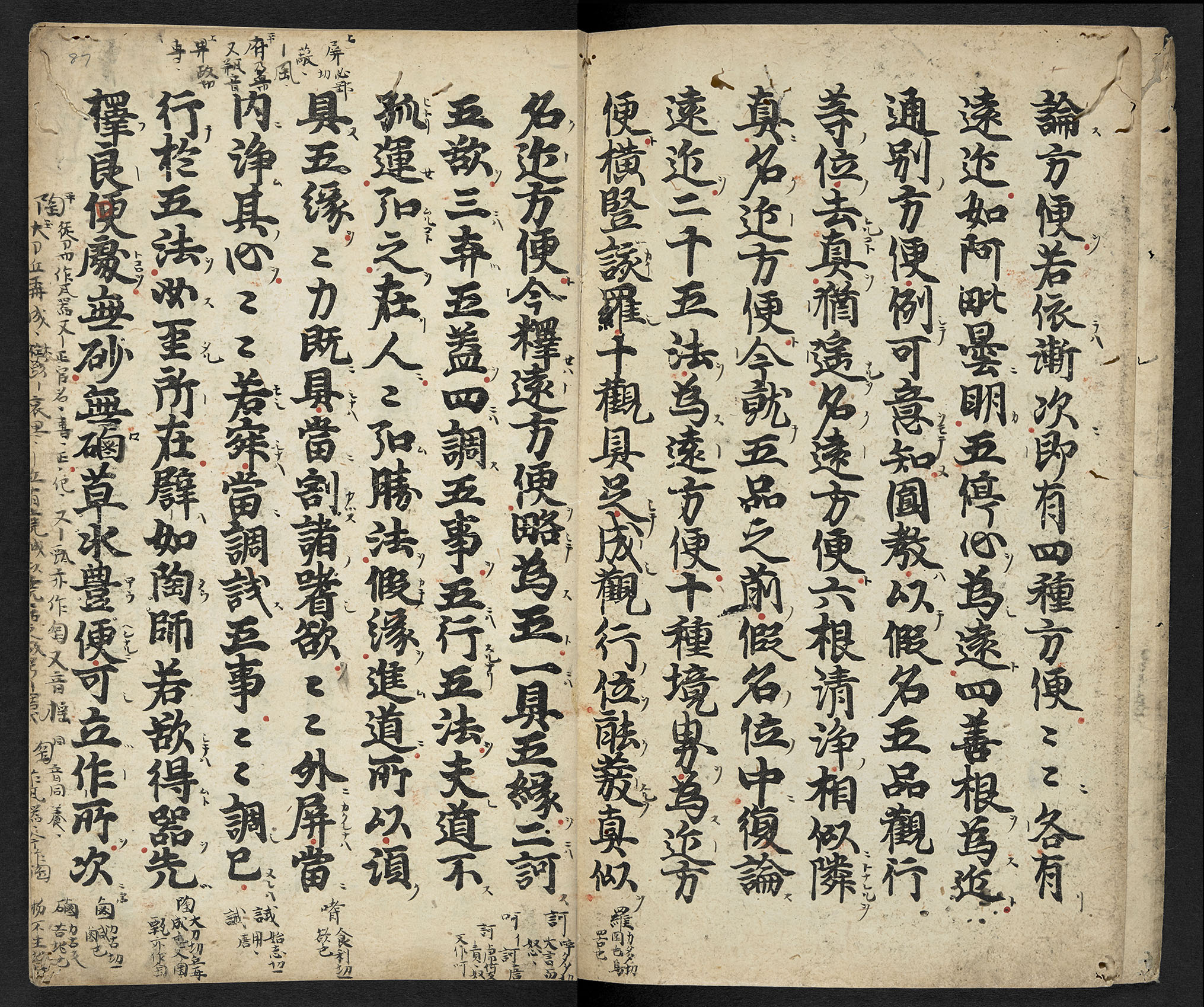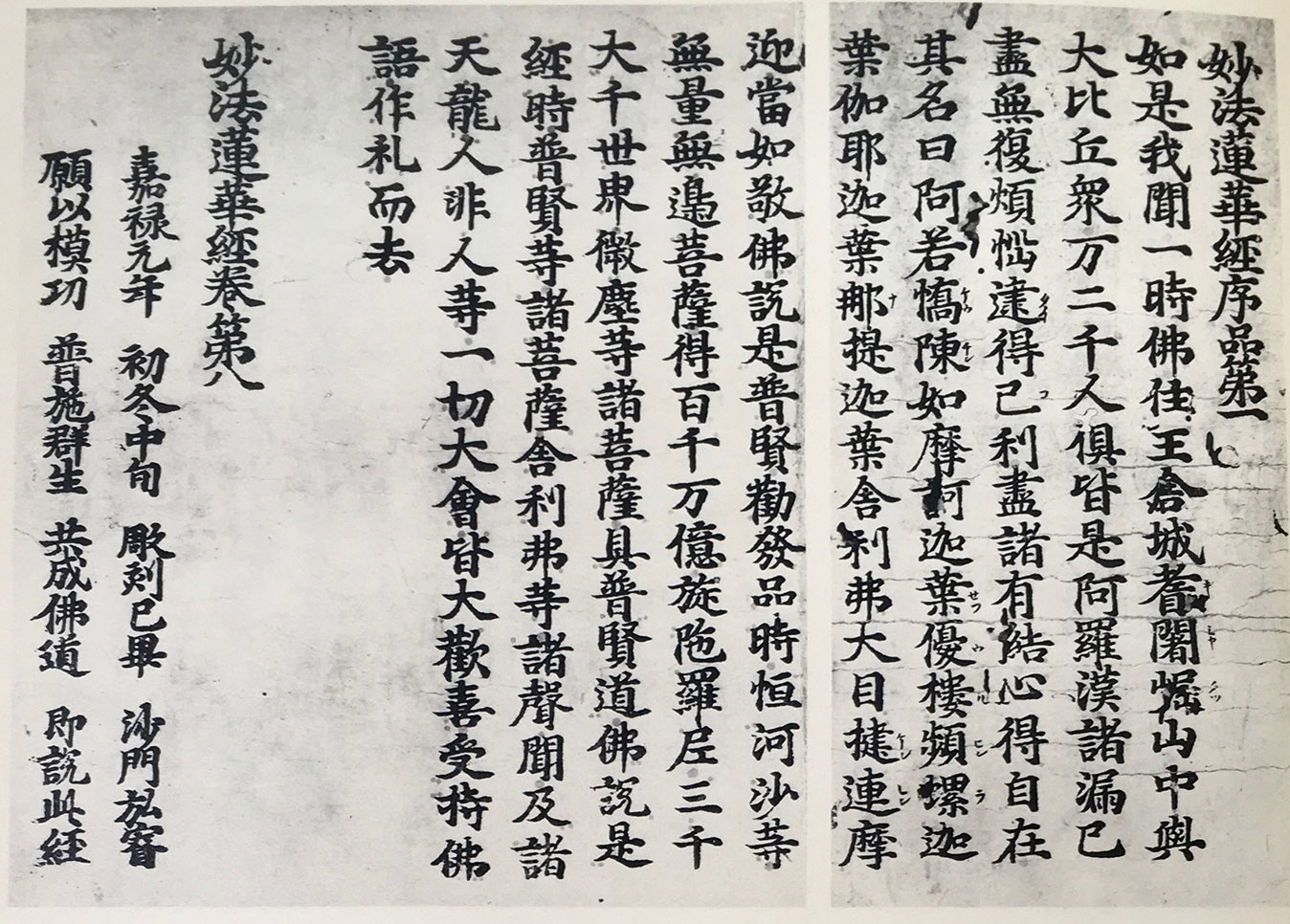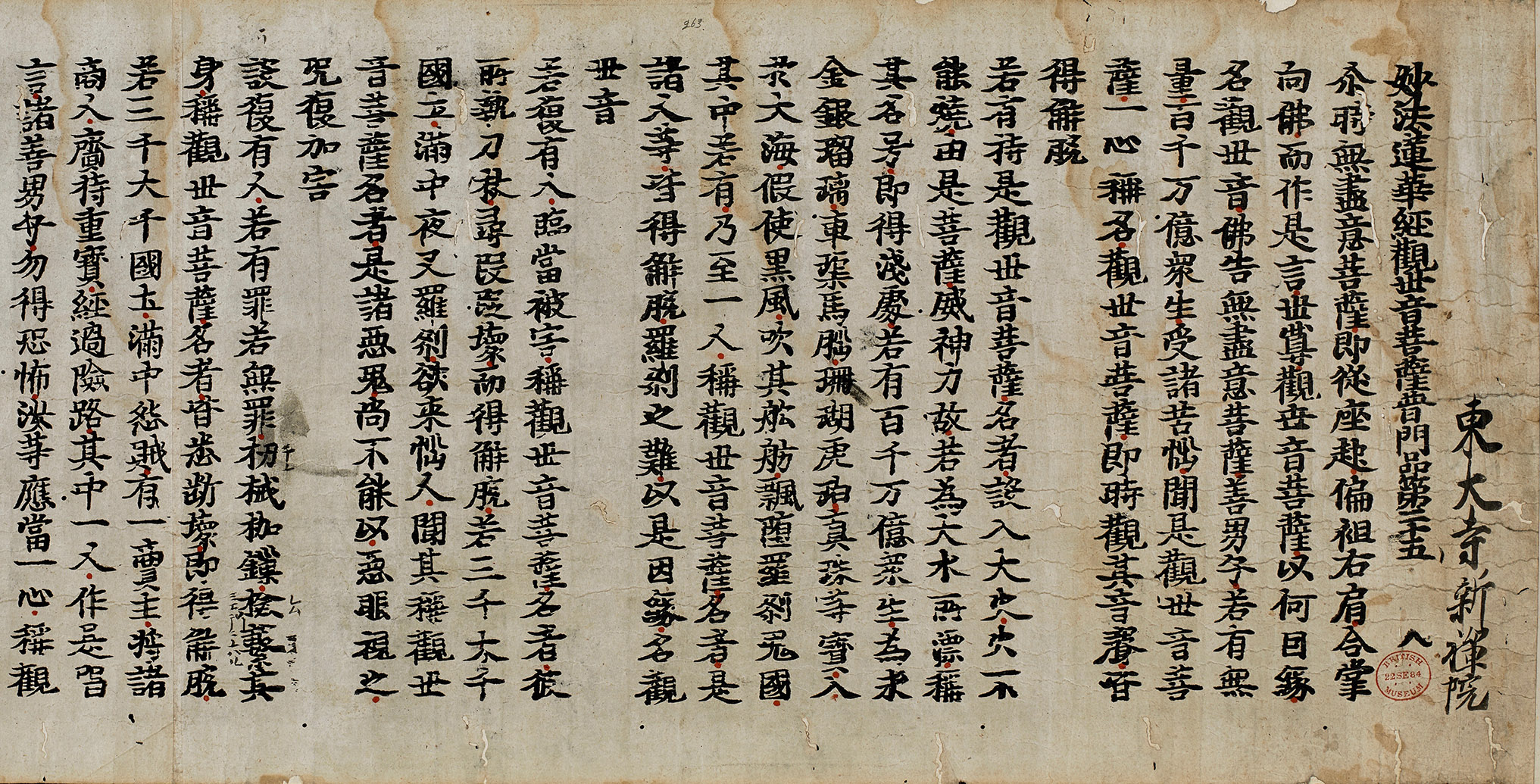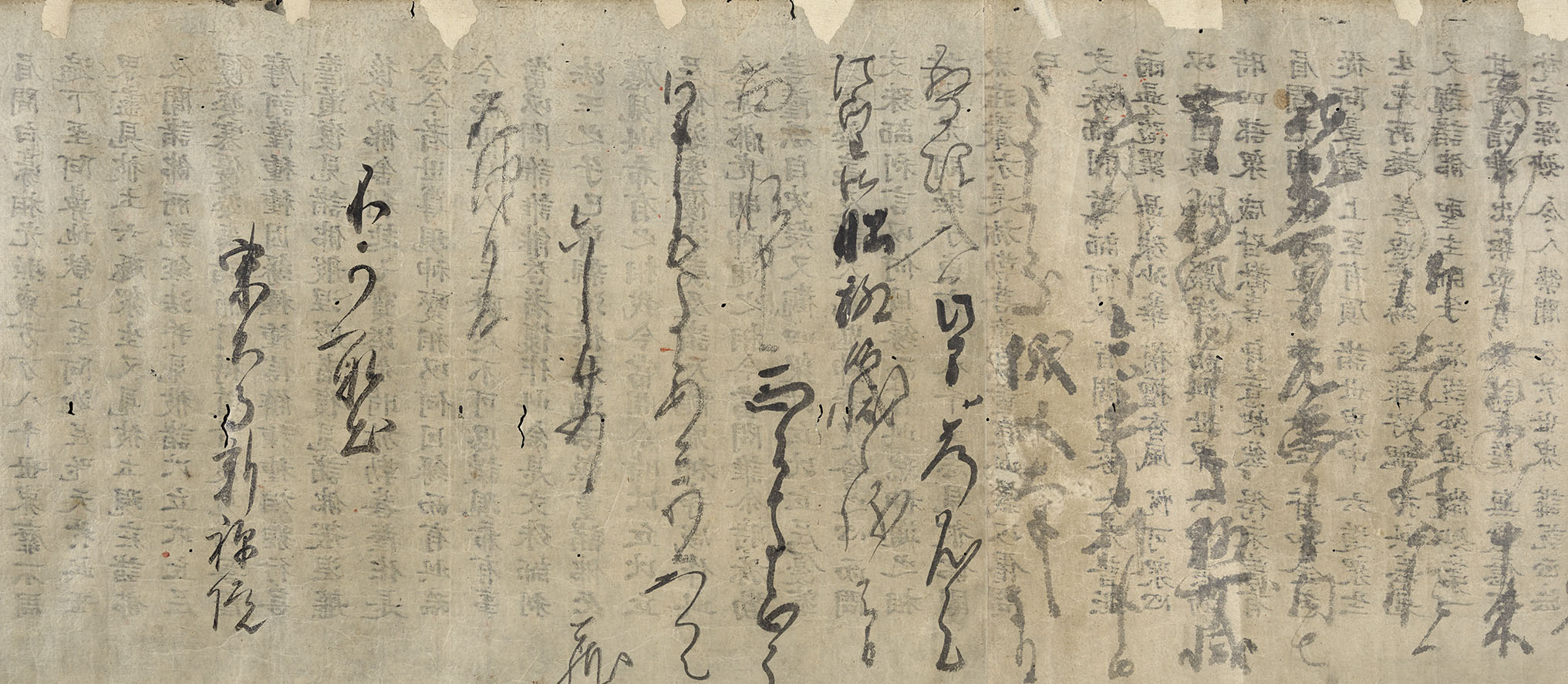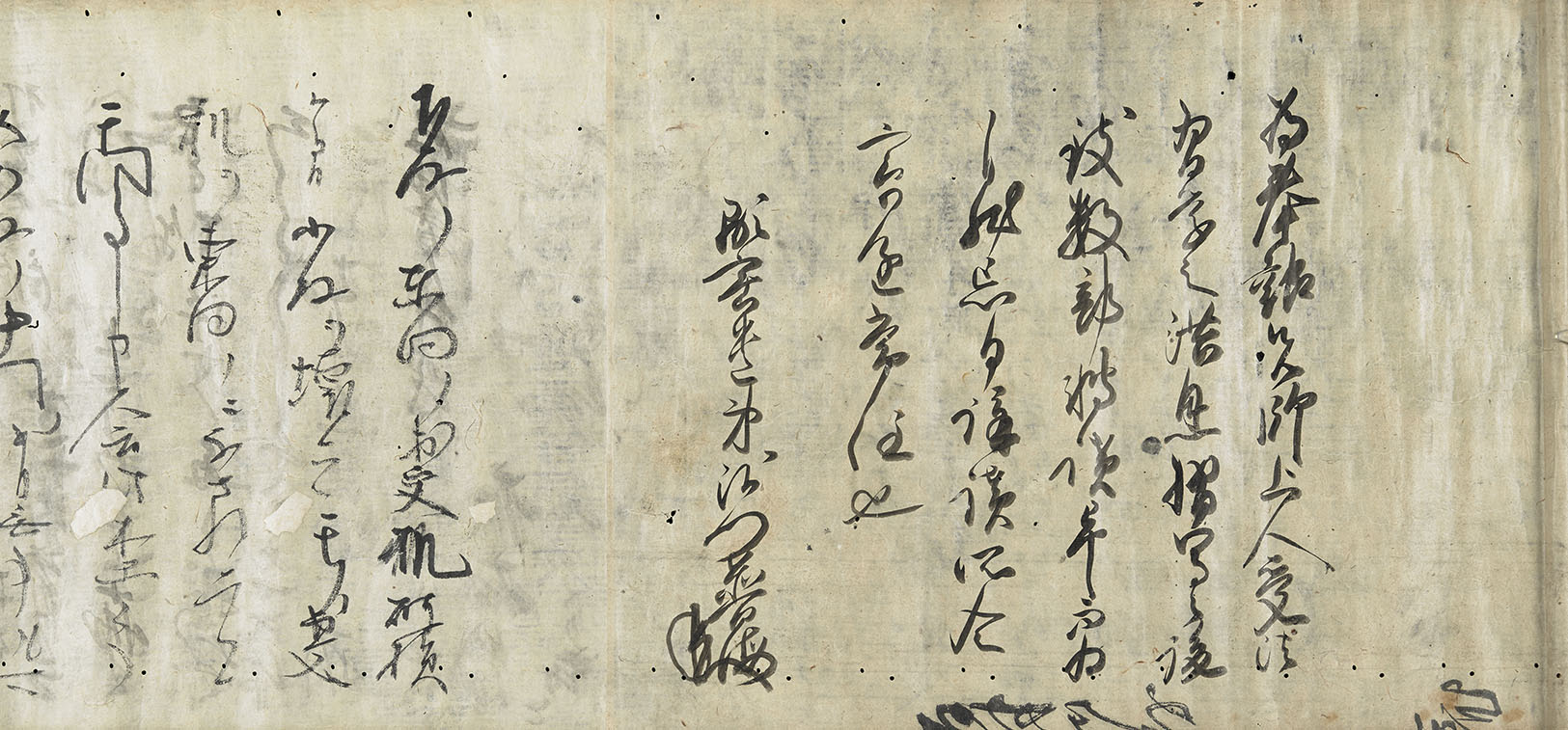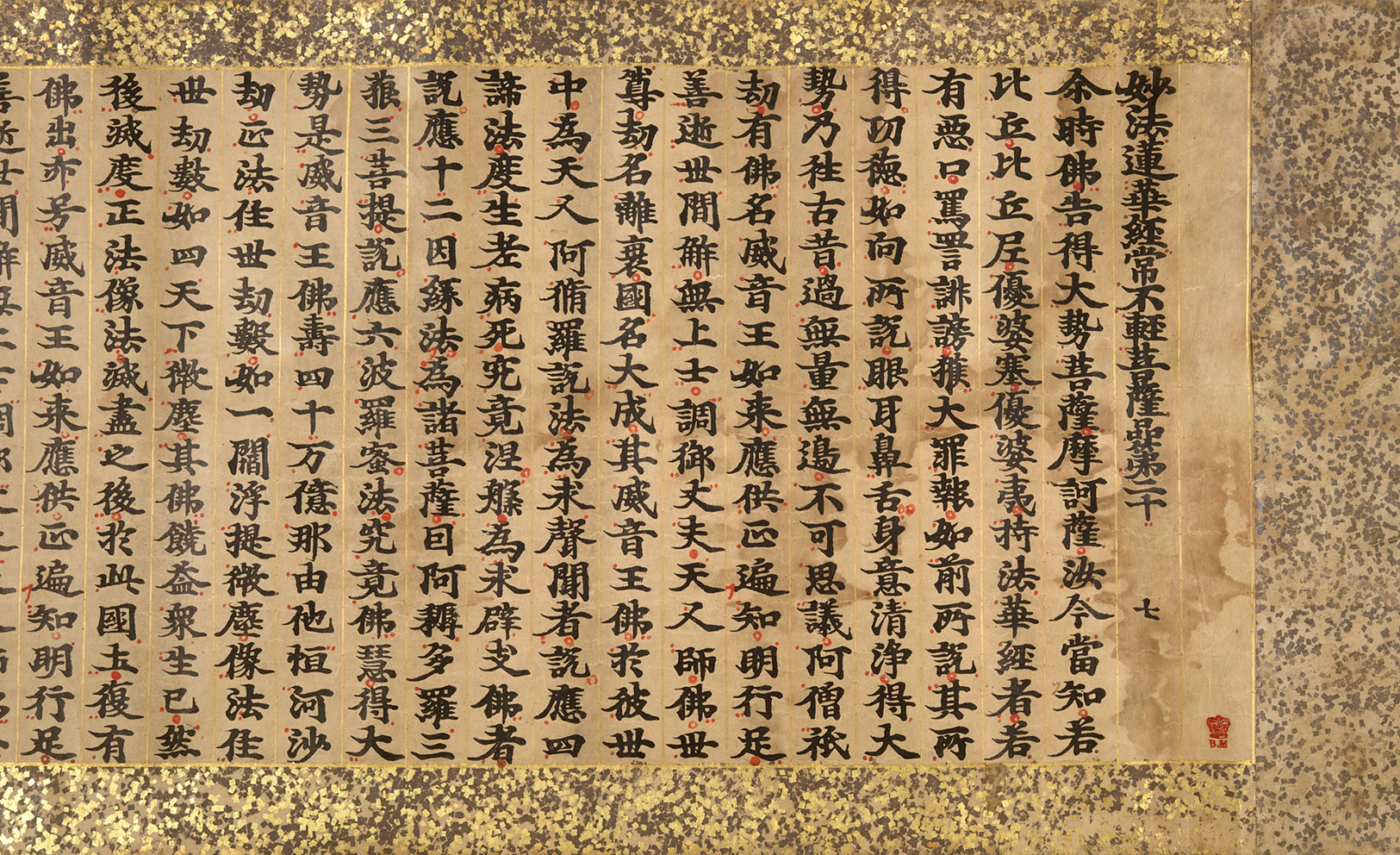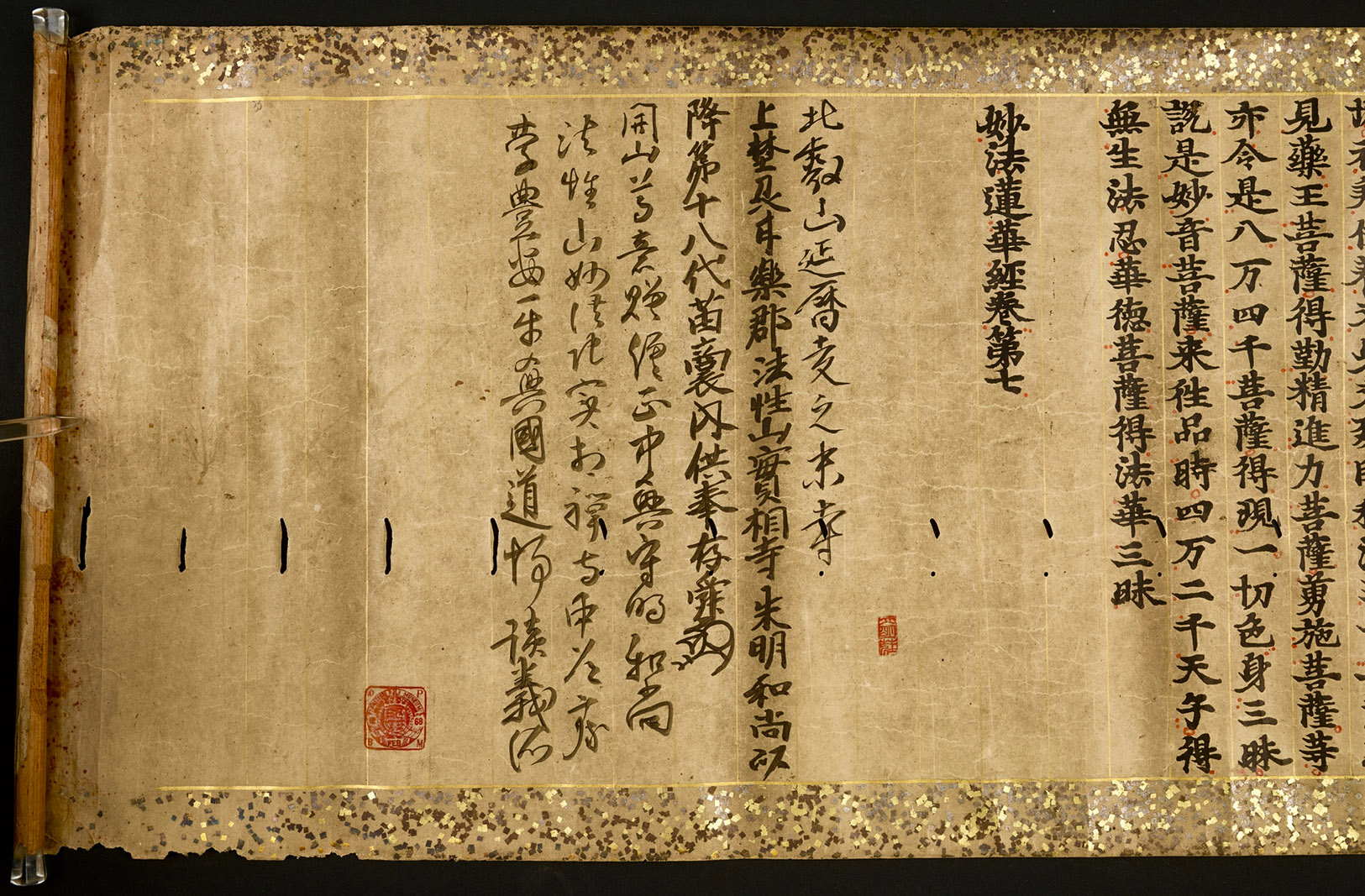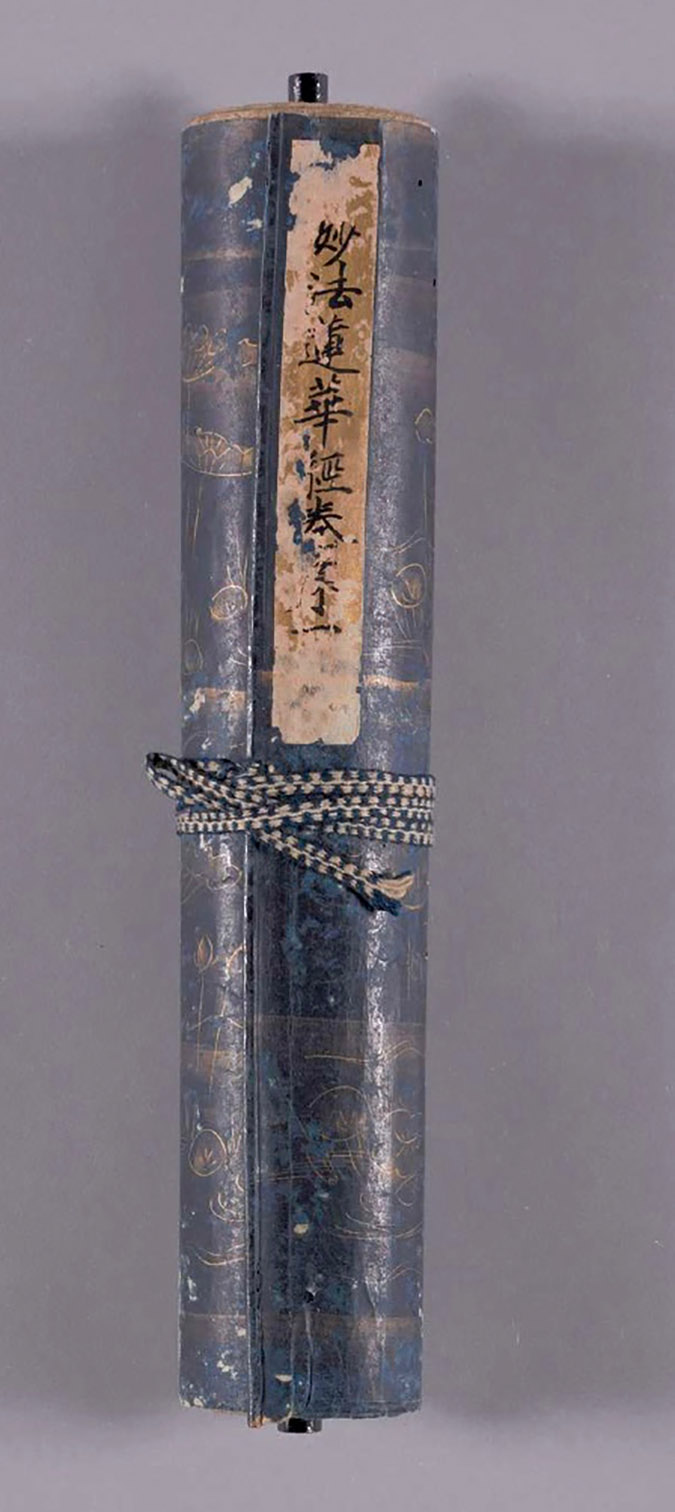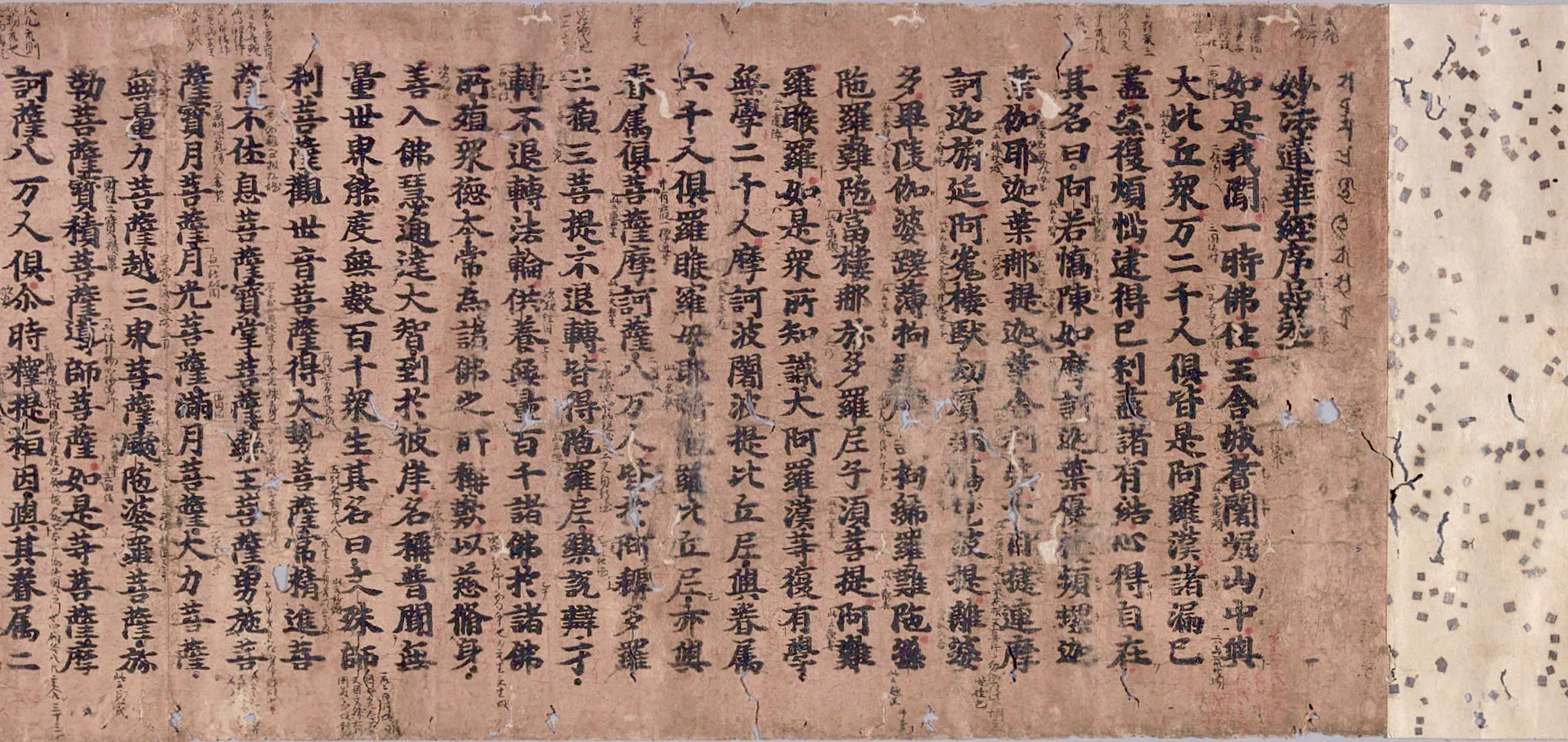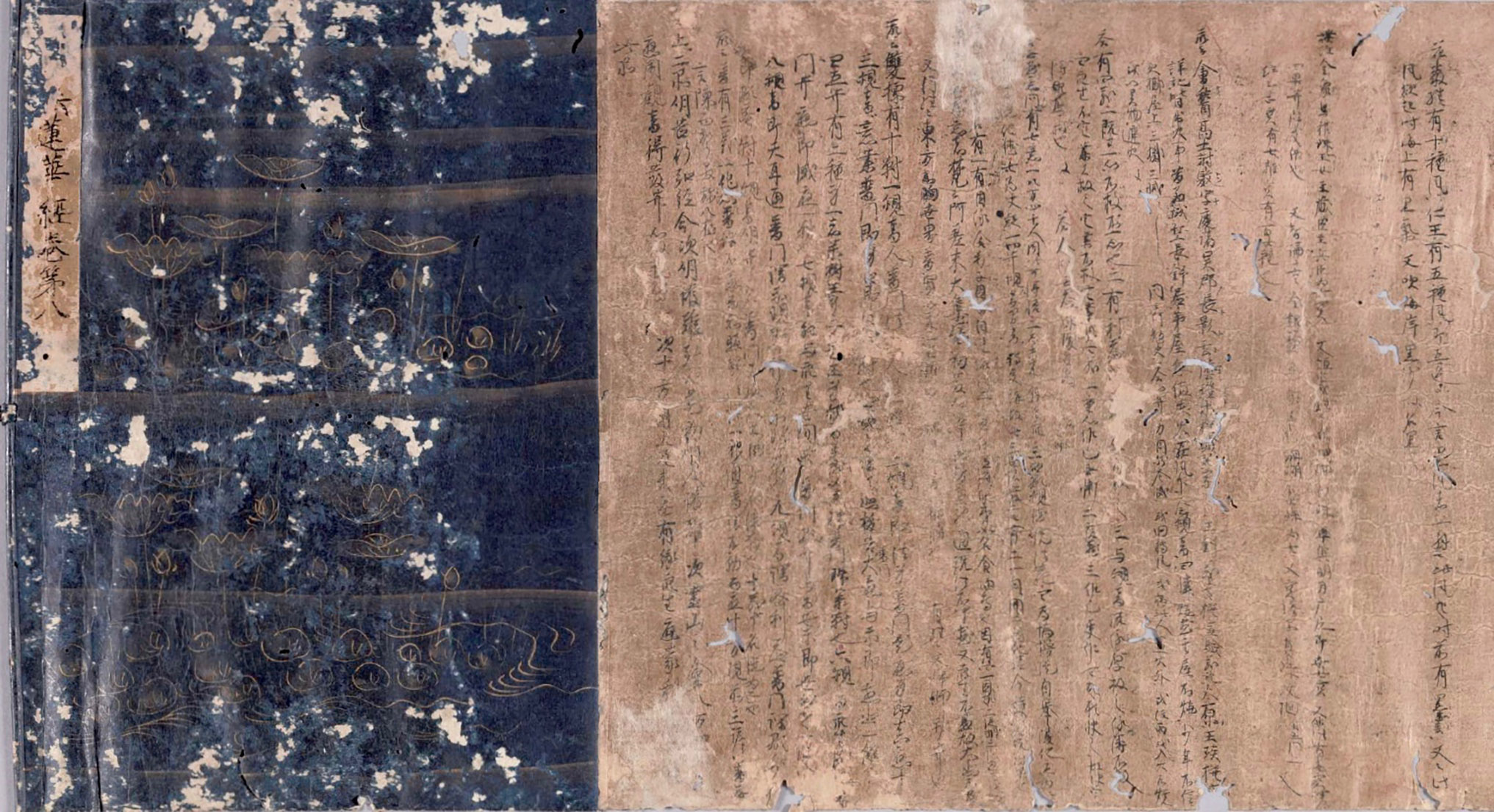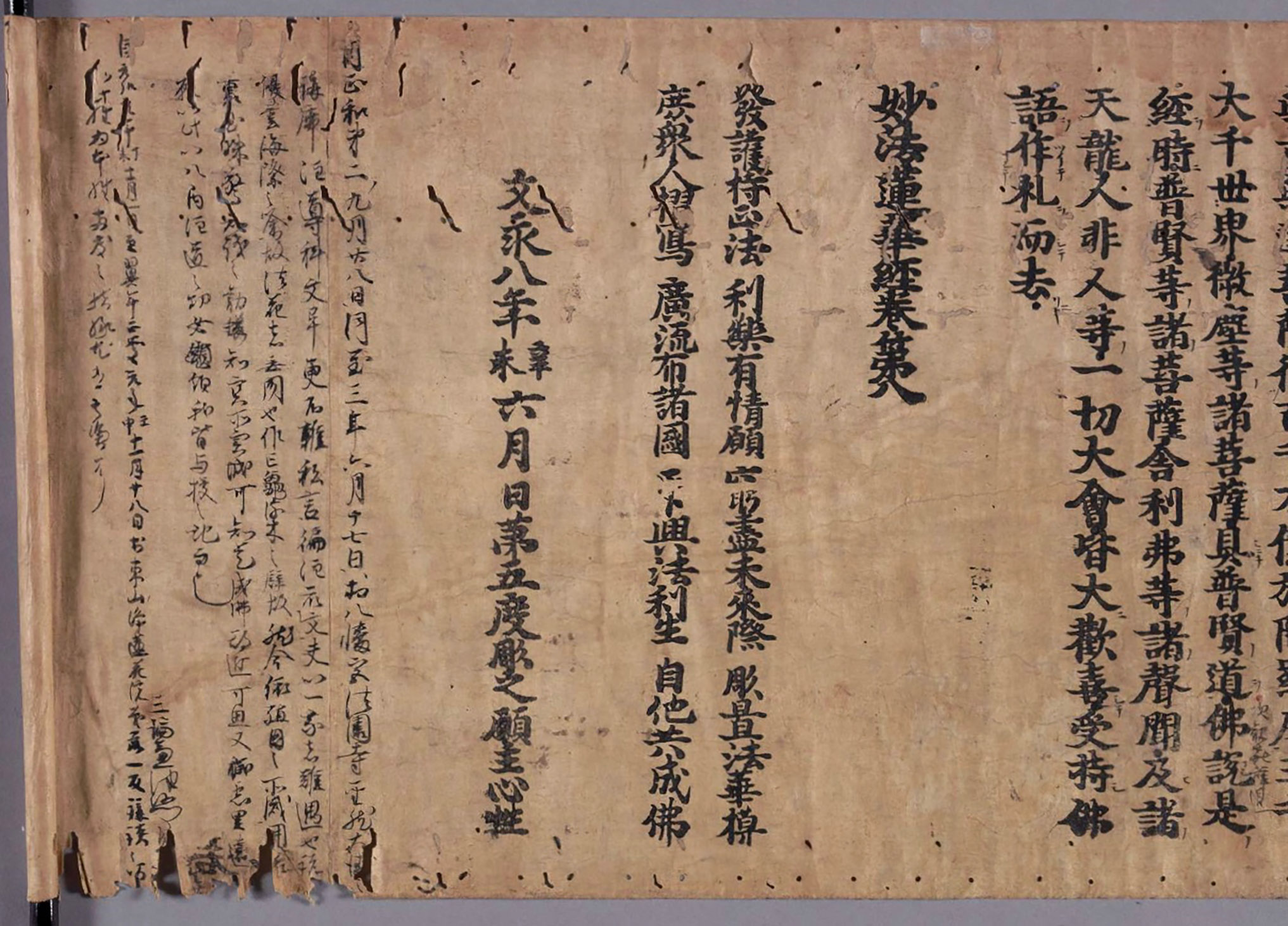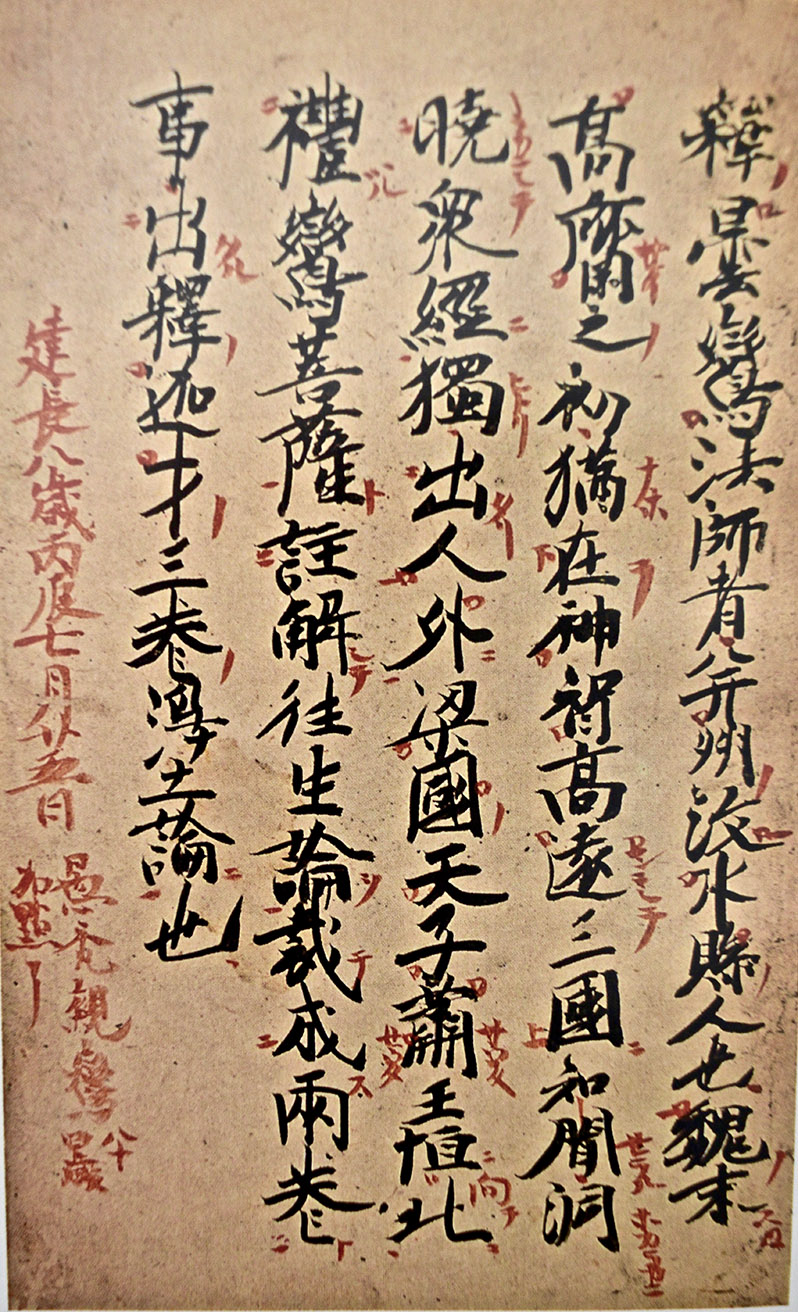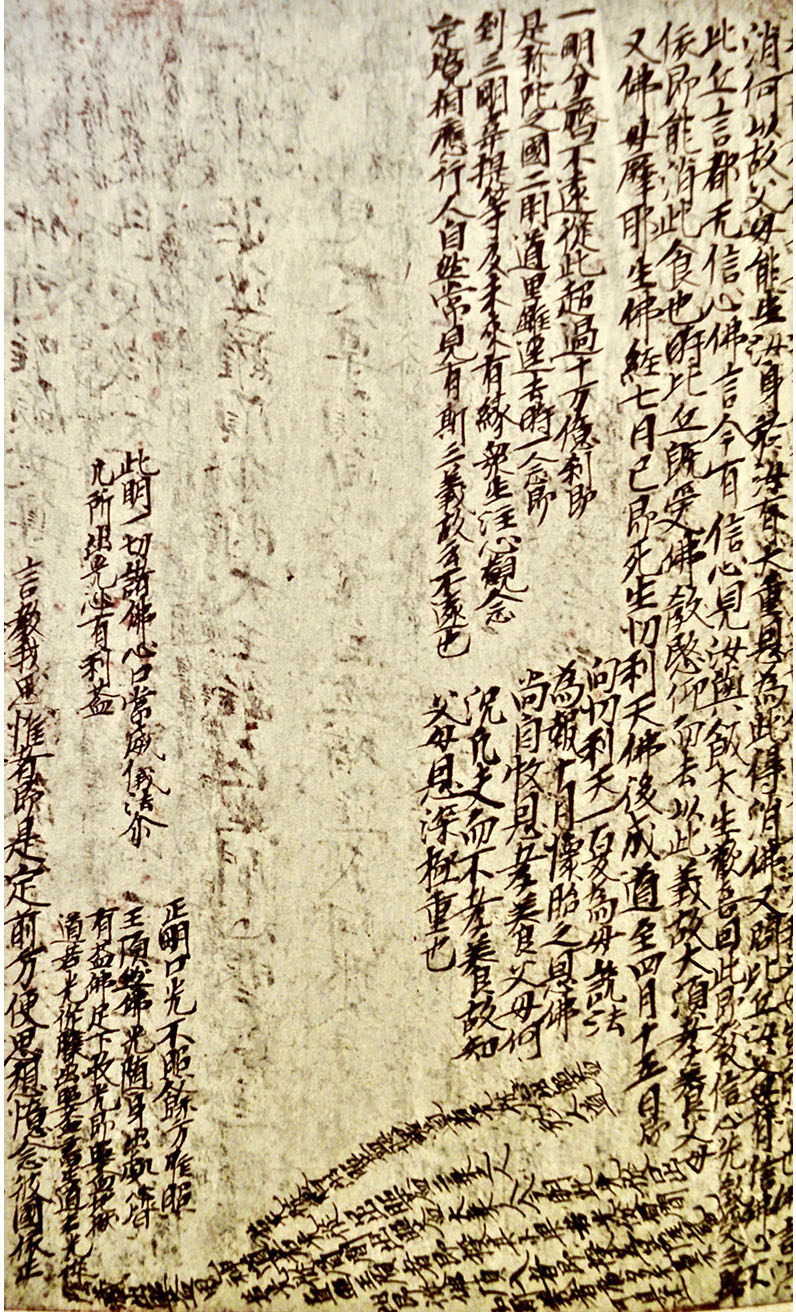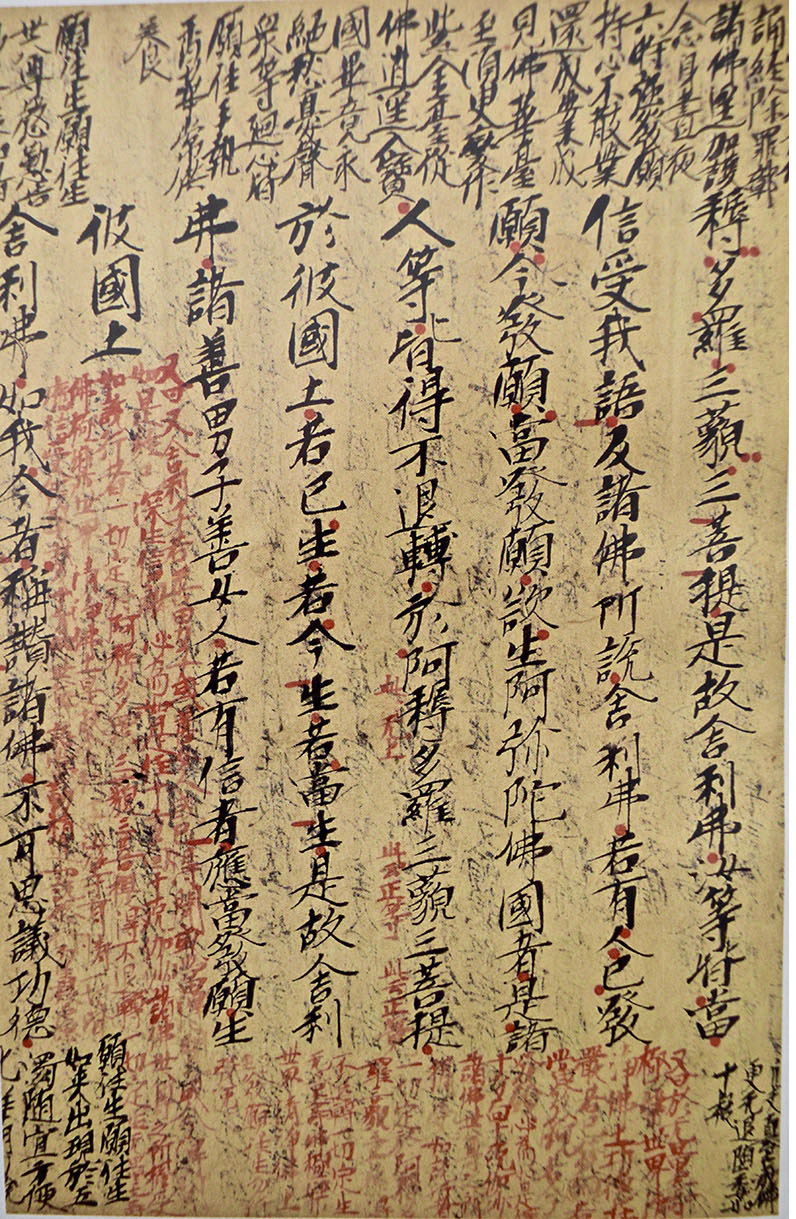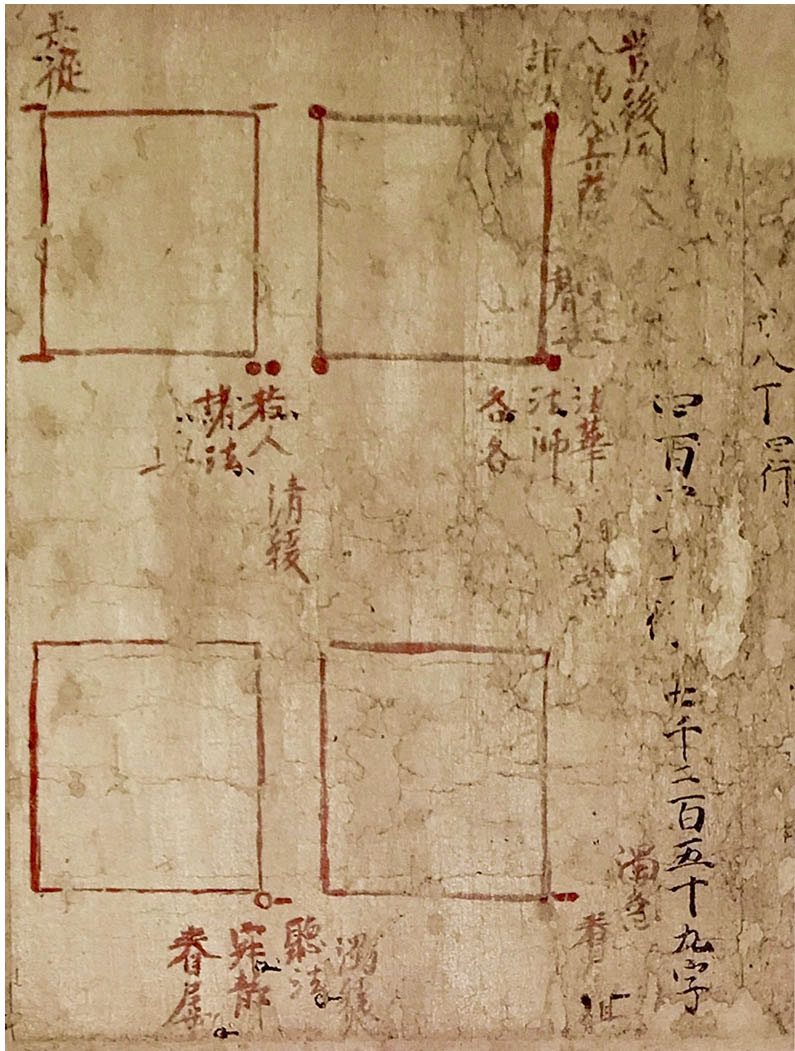Introduction
Among the many exceptionally well-preserved holographic writings by the monk Nichiren 日蓮 (1222–1282) is a work known as Chū Hokekyō 註法華經 (Annotated Lotus Sutra). It consists of a printed copy of the Lotus Sutra and its accompanying scriptures, probably published in the Nara area in the early Kamakura period (1185–1333). On it Nichiren wrote “notes” consisting of quotations from other texts, filling the upper and lower margins of the printed area, the space between the lines of the scripture, the negative space before the beginning and at the end of a chapter, and the verso of the scrolls (figs. 1–4). Nichiren’s handwritten interventions transformed the printed scrolls into a palimpsestic text where the solemn, regular sequence of sutra lines mixes and interweaves with the scattered lines of many other sacred texts, there transposed by the distinctive, spirited cursive hand of its reader.1 At first look, the result of such accretions is an unexpected, unconventional object that may surprise those used to regarding sutras as a category of objects treated with deference. As “written embodiment” of the Buddha, scriptures are revered not necessarily for what is written in them but as objects imbued with power, continuously activated through performative actions: reciting, copying, or simply holding them. The reproduction of sutras by copying, in particular, has been seen as the first and foremost meritorious act of a Buddhist, often carried out in ascetic modes, the purity of material and scribes as a warranty for the efficacy of the action. Yet, these dynamics do not appear to be primary in the scripture that Nichiren inscribed nor in the act of copying the many other sacred writings that are overlapped onto that scripture. The scripture seems to have been used as a convenient medium to write down passages from the vast Buddhist production, its mysterious power transformed into a commodity, an object that may be acquired (perhaps at a price) and eventually used as a notebook.
The existence of a compelling object such as the Annotated Lotus Sutra confronts us with questions on the nature of printing and writing in medieval Japan (eleventh to sixteenth centuries) and elicits a reframing of the discourse on the material culture of Buddhist sutras. From the perspective of visual and conceptual analysis, it asks what kind of hypertext the handwritten interventions on the sutra generate: what kind of information is supplemented by the “notes,” to whom it is directed, whether there is a relation between what is inserted and the point of the scripture at which it is inserted, whether the reader can switch from one text to the other or establish hierarchies among the two. The hybrid composition created by the annotations calls for a comparison with the use of glosses and marginalia in other cultural contexts and encourages us to explore the interventions on printed scriptures as paratexts, apparently liminal elements that become indexes to the transformation of a text through its individual reuse and repurposing.2 From a historical point of view, Nichiren’s Lotus Sutra urges us to interrogate the function of printed scriptures in medieval Japan: Were sutras printed to be used as learning tools (reading matter and reference material), or does Nichiren’s specimen document a practice of repurposing scriptures originally printed for other reasons? If the latter was an accepted way of dealing with printed scripture, was this a continuous process of repurposing that affected the physical form of the object as well as its social life?
To explore these questions I shall first reconstruct the life of the Annotated Lotus Sutra as an object that was produced with specific techniques before Nichiren started using it, and that continued its life after Nichiren’s death, highlighting the different identities that it carried.3 To avoid an idiosyncratic biography, however, I shall go beyond the life of this particular object and consider the larger context and longer-term shifts in the production of the genre to which this belongs, that is, printed scriptures.4 I shall do so by retrieving the printing history of the scripture owned by Nichiren, the Lotus Sutra, in medieval Japan and the diverse practices of repurposing that affected the genre of printed scriptures in general. This is particularly relevant as little has been written in anglophone scholarship on printed sutras and, indeed, on printing before the early modern period.
Nichiren’s Chū hokekyō: The Biography of a Book
Material Features
Chū Hokekyō (Annotated Lotus Sutra), the title by which the copy of the Lotus Sutra owned by Nichiren is known, consists of the Lotus Sutra proper in eight scrolls (kan 巻) and the two scriptures that were considered its opening and closing sutras, that is, the Sutra of Innumerable Meanings (Wuliangyi jing 無量義經) and Sutra on the Contemplation of Samantabhadra (Guan Buxian jing 觀普賢經), each in one scroll.5 Bound in ten handscrolls, the Annotated Lotus Sutra is printed on high-quality white ganpi 雁皮 paper with an eggshell texture (torinoko 鳥の子) and mixed with powdered mica. Each chapter is made of a varying number of paper sheets glued together, from a minimum of twenty-one to a maximum of twenty-nine. The size of the sheet is roughly 27.3 centimeters in height, with twenty-two lines per sheet and an interlinear space of 2.1cm (7 bu). The length of each scroll is between 8.63 meters (kan 8) and 12.30 meters (kan 2).
Some 2,106 passages are transcribed on the printed text. None of the holographic annotations are Nichiren’s own words or his direct commentary on the sutra. They are rather “citations,” verbatim and not, from a varied range of other texts. Nichiren drew on more than three hundred Buddhist works of diverse genre, from other sutras to the doctrinal treatises of different Buddhist schools, ritual manuals, and historical records. Nichiren might have considered these works important to flesh out his own understanding of the Lotus Sutra. In fact, the passages inscribed are reused in about 208 of Nichiren’s own writings. Three passages, one in Chapter One, one in Chapter Two and one in Chapter Four, are not in Nichiren’s hand and are thought to have been inserted by one of his disciples, Nikkō 日興, because the same sentences appear in a work attributed to the latter, “The Record of Orally Transmitted Teachings” (Ongi kuden 御義口伝).6
No rationale can be detected as to where passages have been inscribed, or why some chapters have more annotations than others (for instance, scrolls 7 and 8 have more space left empty on the recto). Sectarian scholars have suggested that the core chapters of the sutra, from Chapter Eleven to Chapter Sixteen, are more extensively annotated because those were the focus of Nichiren’s understanding of the sutra, and that key passages explaining the sutra were inscribed in that space, while passages from works that are unrelated to the sutra were inserted in the closing sutra (fig. 4).7 A close analysis of the text, however, shows that the relevance of any one scriptural annotation to Nichiren’s hermeneutics depends on the scholar’s interpretation of what was important in Nichiren’s system of thought, and thus a matter open to agendas other than those inherent to the text.8
Timeline
As with any biography, dates are relevant to reconstruct the life of this object. Being a printed scripture later inscribed by hand, two sets of dates are significant for the Annotated Lotus Sutra: those concerning the original text and those related to the manuscript hypertext.
The Printed Scripture
It is not easy to retrieve the circumstances in which the edition of the Lotus Sutra owned by Nichiren was printed and whether other impressions exist of the same edition. Difficult to identify is also the sutra recension that was used for this printing. The edition is not dated and does not bear the name or place of the publisher. When the Annotated Lotus Sutra was designated as an Important Cultural Property (juyō bunkazai) in 1952, it was recorded as a Mt. Hiei edition (eizanban 叡山版) of the Lotus Sutra. However, there are no known medieval editions of the Lotus Sutra printed at the headquarters of the Tendai school on Mt. Hiei.9 Scholars who have investigated Buddhist printing in the medieval period mostly agree that it is a sutra printed in Nara, a so-called Kasuga edition, which bears close resemblance to the printed Lotus Sutra published by the monk Shinjō 心性 (n.d).10 I shall come back to this important edition and follow the story of its publication and circulation.
Based on comparison with the calligraphy of other works by Nichiren, the historian of sutra printing Kabutogi Shōkō suggested that the printed text was annotated after the Kōchō 弘長 years (1261–64), and therefore the sutra itself must have been printed before or around this period. Of the Kasuga editions of the Lotus Sutra produced before then and still extant, the fourth of Shinjō’s editions is known to have been printed starting from Kōchō 3 (1263; fig. 5). A comparative analysis of formal elements shows that both this and Nichiren’s sutra feature the same character size and interlinear space. However, in its entirety the impression owned by Nichiren does not match exactly any of the editions preserved (for instance, some characters are different).11 These small differences might be due to the fact that it is a reprint for which some pages were engraved anew, or that it is an earlier edition of the Shinjō’s Lotus Sutra, no longer exant.12
The Annotated Text
The compilation of the Annotated Lotus Sutra, that is, the date(s) of the inscriptions, has been debated by modern sectarian scholars. Three main theories have emerged that reiterate the different phases into which Nichiren’s life is often divided. The first theory places its compilation in the years before or immediately after Nichiren proclaimed his own “school” (1253), while he was studying at various temples around the country. The annotations would thus testify to Nichiren’s interest in learning about different forms of Buddhism, justifying the transcription of passages from works that do not reflect Nichiren’s mature interpretation of a Lotus Sutra–focused Buddhism. The second theory suggests the years between the exile in Sado (1271) and Nichiren’s move to Mt. Minobu (1274). This theory has been broadly favored because the Annotated Lotus Sutra contains many passages that are also quoted in major works Nichiren authored while on Sado, such as Kanjin honzonshō 観心本尊抄, Kenbutsu miraiki 顕佛未来記, and Kaimokushō 開目抄, all treatises covering important doctrinal matters. (On the contrary, it omits sources quoted in writings compiled before the exile.) The very context of an exile, however, raises questions as to how Nichiren might have been able to consult so many Buddhist works in remote areas of Japan: the number of sources available in Sado must have been quite limited, even though Nichiren’s correspondence with his followers provides evidence that he often requested books.13
A third possibility is that Nichiren compiled the Annotated Lotus Sutra in Minobu, where he spent the last years of his life.14 It has also been suggested that the Annotated Lotus Sutra handed down to the present day is the result of Nichiren sorting and rearranging the scattered books in his collection along with the essential passages that he had transcribed previously. From a letter Nichiren sent from Minobu to two of his disciples, it can be inferred that he had lost a similar collection of scriptural passages.15 We know that before being exiled Nichiren was able to consult a great many texts directly—for instance, while he was writing the Risshō ankokuron 立正安国論 he used the Buddhist canon (issaikyō 一切経) held at Iwamoto Jissōji 岩本實相寺 (fig. 6).16 It is thus possible that by the time of his exile on Sado, Nichiren had copied key texts and organized them into an anthology that might have been a prototype of the Annotated Lotus Sutra. If this was damaged or lost, at least in part, due to the hardships Nichiren experienced, he might have created a new compilation once he settled in Minobu.17 He must have had other works with him though, for not all the quotations included in works written in Minobu are recorded in the Annotated Lotus Sutra as we have it. Why textual passages would be inscribed onto a copy of the Lotus Sutra, however, remains unexplained. One also wonders whether he came into possession of the printed copy of the sutra while in Minobu or only annotated it during those years. Paleographic analysis of Nichiren’s early works shows that citations from the Lotus Sutra use characters different from those of the Annotated edition and raise questions as to whether Nichiren used a different edition of the sutra at that time or used allographs in a reflection of his own preference.18
Because most suppositions regarding the dates of the Annotated Lotus Sutra are made on the basis of Nichiren’s reuse of the notes in the many letters and treatises that he authored, they are too blurred by sectarian concerns to draw a consistent picture of Nichiren. When reconsidered from a material-culture perspective, though, these theories bring to the fore compelling evidence of the circulation of texts in medieval Japan and their repurposing in different formats. Fragments of texts that Nichiren had inserted in the closed space of a printed book took on a new life when lifted from this (already secondary) context and added to new passages to create another text, of different kind, a letter or a treatise, which in turn entered a new network of people, disciples, and lay followers, and later copyists and paper craftsmen.19
Afterlife
Today the Annotated Lotus Sutra is kept in the archives of Tamazawa Myōhokkeji 玉沢妙法華寺, a temple of the Nichiren school in Mishima, Shizuoka prefecture. How did it come to be at this location? Who owned it after Nichiren’s death?
A record of Nichiren’s funeral, compiled at the moment of Nichiren’s death, reports Nichiren’s instructions on what to do with his few possessions. Of the Annotated Lotus Sutra it says:
Other records of the distribution of Nichiren’s belongings, however, document that three days before dying Nichiren bequeathed the scripture to one of his six main disciples, Ben’ajari Nisshō 弁阿闍梨日昭 (1221–1323).21 Nisshō would go on to establish the Myōhokkeji, where he kept the Annotated Lotus Sutra. In a letter that he wrote to his disciple Nichiyū 日祐, the third abbot of Nakayama Hokekyō, he proclaimed the Annotated Lotus Sutra as the “important treasure” (jū hō 重宝) of their lineage because it inscribed passages by the founder and exhorted his disciples not to forget the value of having been bequeathed this sutra.22As for the sutra, that is, “my anthology of most essential passages” (Shishū saiyōmon 私集最要文), which I/we call “Annotated Lotus Sutra” (Chū hokekyō 注法華経), this is also to be treasured and placed in the temple [where] my grave [will be], and when the six elders will come to offer flowers and incense, they should peruse it (hiken 披見), for all other sacred writings are no match.20
These two documents put emphasis on different functions of the material book inscribed by Nichiren. The first suggests that the scripture was to be venerated like the statue of Śākyamuni that Nichiren owned, which was to be placed next to his grave (and was bequeathed to another disciple). The book in this case is considered in terms of its primary text, a precious copy of a sutra, of which not many could be easily acquired. The second document, however, cherishes it as a work by Nichiren and considers it a token of his heritage.
It is as a carrier of the master’s legacy that the Annotated Lotus Sutra took on a life of its own. Although the book was not supposed to leave the lineage, records show that in the sixteenth century the incumbent abbot of Ikegami Honmonji, Nissei 日惺 (1550–1598), requested to loan it in order to print it. He sent another work by Nichiren as a proof of the loan, but once the book was copied, five of the ten scrolls were not returned. The book thus remained fragmented in two locations for centuries, until the two parts were reconciled in 1941.23 In the Edo period the book was printed twice. The first print was run in 1681. A second edition was run in 1751 at Yōbōji 要法寺 (Yōbōjiban) from a new set of wood blocks.24 Known as Nissei’s edition (seishibon 惺師本), according to the colophon inscribed in the second edition, Nissei had instructed a disciple to copy Nichiren’s holograph in 1595. Printed in ten fascicles (satsu 冊), these editions transformed the original text by reformatting its layout: the lines of the Lotus Sutra itself were abbreviated and disappeared, while the handwritten marginalia became the main text (figs. 7, 8).25 Gathered under the title of each chapter of the sutra, although not always the chapter where Nichiren had originally inserted them, the annotations lost their visual and conceptual connection with the original scripture in its printed format. Considering that several passages were unrelated to the commentarial tradition of the Lotus Sutra, the references to the hypotext became even looser. This formal reorganization betrays a concern with authorship, a problem that often surfaces in the reading of marginalia. While the holographic Annotated Lotus Sutra exposed the ambiguous position of a multiple text of which no part, neither the sutra nor the textual sources of the passages inscribed, was authored by Nichiren, the new format asserted Nichiren’s “editorial rights,” if we can say so, in putting the passages together and posited the anthology as a taxonomy of Nichiren’s knowledge: the list of passages became an index to his learning and his distinctive thought.26 As a matter of fact, this edition missed some fifty passages of Nichiren’s annotations and instead included some personal explanations by Nissei. Further, it expanded some of the quotations that Nichiren had inserted in abbreviated form.27 In short, it effectively created a new layer of paratexts.
Modern editions published in the twentieth century subjected the text to other metamorphoses that create an alternative text. The Annotated Lotus Sutra was printed for the third time in 1932 after the annotations had been collated and corrected—a work started by scholar Katō Bunyu at the end of the nineteenth century. In this edition the passages transcribed by Nichiren, originally all in kanbun, are translated into Japanese, and the text is supplemented by a volume of critical apparatus.28 Postwar publications sealed the status of the Annotated Lotus Sutra as a work valuable for the sectarian and cultural communities in which it was produced and highlighted other concerns. In 1955 a photographic reproduction of the entire text, printed in collotype, was made. This would later be included in the collection of Nichiren holographic works, conveying the need to preserve the founder’s writings and make them visible as cultural assets (fig. 9).29 Further, a critical edition was produced, with indexes to the sources from which Nichiren transcribed the passages, placing the text firmly within the scholarly domain.30
This short reconstruction of the life and afterlife of the Annotated Lotus Sutra leaves a host of unresolved questions regarding the printed book that Nichiren owned and his interventions. I shall not engage here with issues arising from the content of the annotations, for I have analyzed elsewhere their bearing as evidence of the hermeneutical strategies that Nichiren formulated to put forward his interpretation of Buddhism.31 Rather I shall turn to the material qualities of the book and its format and put it in relation to the practices of printing and using printed scriptures in the medieval period. What kind of printed book was the Lotus Sutra that Nichiren owned? Were many Lotus Sutras printed and circulated in medieval Japan? How could one acquire a printed scripture? Was Nichiren unique among medieval scholar-monks in scribbling onto a printed sutra, or did all scholar monks possess scriptures onto which they jotted other texts? How many scriptures were repurposed through annotations, and what was the nature of such paratextual accretions?
Printing Sutras in Medieval Japan
Histories of printing in Japan have devoted relatively scant attention to the production of books before the early modern period. If is often noted that after a remarkable beginning in the eighth century, very little was printed in Japan for commercial purposes until the sixteenth century. Most surveys of early printed books in English gloss over the medieval period, with only a few references to the fact that during those centuries most publications were of Buddhist works.32 This seems curious when one considers that printing in East Asia emerged in close relation to Buddhism, spread along with Buddhism, and in Japan, a profoundly Buddhist society, evolved in response to the needs of the Buddhist community.33 If one also considers the size of most Buddhist texts, the volume of printed material was indeed substantial. Printing appears to have had a resurgence in the early medieval period, and Chōnen’s 奝然 (938–1016) return from China in 985 with a complete printed edition of the Buddhist tripitaka is often cited as the factor that revived printing. Chōnen’s set of 5,048 volumes of Buddhist scriptures, which would be known as the Kaibao tripitaka, was donated to him by the Song emperor Taizong 太宗, who had sponsored the printing of the canon.34 It was placed in Michinaga’s temple, Hōjōji 法成寺, and it is said to have served as the master copy of successive printings. Yet not all sutras printed in Japan in the subsequent centuries were from this edition; other Chinese editions as well as the Koryŏ edition of the tripitaka were brought to Japan between the eleventh and twelfth centuries.35
The oldest mention of sutra printing in the early medieval period is of a Lotus Sutra: an entry in Fujiwara Michinaga’s 藤原道長 diary records that in 1009 he had a thousand copies of the Lotus Sutra printed for a large-scale ceremony.36 These copies have not survived to allow analysis of their material features, but their use in a liturgical setting suggests a devotional motivation for printing. In the Kamakura period prominent printing centers remained at Nara and its major temples, Kōfukuji, Saidaiji, Tōshōdaiji, Tōdaiji, and Hōryūji. But by the thirteenth century printing had also spread to other areas of Japan with established monastic communities, from Kyoto and Mt. Hiei to locations further afield, Kōyasan and Negoro in the south, and Chōrakuji 長楽寺 in Kōzuke 上野 province (today’s Gunma prefecture) in the northeast.37 These temples printed doctrinal works relevant to their school. For instance, the so-called Eizan editions, produced at Enryakuji, consisted of the three classic works by the Tendai patriarch Zhiyi 智顗 and their commentaries, such as the Kōan-period impression of Zhiyi’s Moho zhiguan 摩訶止観 and of Zhanran 湛然 Fahua xuanyi shiqian 法華玄義釋籤 held at the British Library, which bear the dedication by the monk who commissioned the printing, Shōsen 承詮 (figs. 10, 11).38 A similar choice of material distinguished the presses at Shingon and Jōdo temples.39 At the end of the thirteenth century and throughout the Muromachi period, Zen temples, both in Kyoto and Kamakura, would introduced a new style of printing from China for their writings (gozanban 五山版).40 Such uncentralized geographical distribution suggests that printing served a training and educational role. In fact, scholars have argued that since the texts printed during the Kamakura period are of better quality than those in previous centuries, they must have been required for reading rather than for devotional use: where with multiple copies printed as offerings the emphasis was on quantity and therefore there was no need for good-quality paper either, reading matters necessitated a clearer impression. However, a closer study of the colophons of many of the scriptures and other canonical writings printed in this period puts this argument into question, as we shall see shortly.
Kasuga-ban
The most important medieval press was housed at Kōfukuji. The many editions of Buddhist works, running to several volumes, that were printed there would be known as kasuga-ban 春日版, from the custom of presenting copies to the deities of Kasuga, the shrines affiliated to Kōfukuji.41 Kasuga editions were characterized by a format with seventeen characters for each line and by the use of good-quality, pale India ink and fine paper. Sutras from this press were usually bound in the handscroll format (kansubon 巻子本), more rarely as double-leaf books (folded and butterfly binding). Many of the wood blocks from which these scriptures were printed still exist, including a set of blocks used for an edition of the canon printed in the thirteenth century. Information on printing, such as the year, the name of the temple, the petitioner, the donor, and more rarely the wood-block cutter were usually included.
It is unclear exactly when the first Kasuga editions were printed. Kōfukuji might have started printing works of relevance to Hossō doctrine, upheld by its monastics, and indeed a perusal of the titles of extant texts printed in the eleventh century gives a range of treatises on the theory of consciousness, with a handful of scriptures used for apotropaic rituals printed.42 Yet in the Kamakura period the production of printed sutras bloomed, perhaps precipitated by the fire of the Jishō year (1177) that destroyed Tōdaiji and Kōfukuji, including their libraries and sutra wood blocks. Kasuga-ban became the most influential format of printed scriptures across medieval Japan, imitated even in the dedication of the printed books to a local kami.43
Printing the Lotus Sutra
Several Kasuga editions of the Lotus Sutra were produced, and it is useful to explore them further to trace the scripture owned by Nichiren to its origins. The Lotus Sutra was the most frequently printed sutra in medieval Japan by a long way, thus mirroring the production of manuscript copies. A survey carried out in the early 1950s unveiled no fewer than eighty-one editions of the Lotus Sutra printed between 1080 and 1614.44 This inventory did not include impressions that are mentioned in literary and historical records but that had not been identified or were no longer extant, nor those that had left the country.
The oldest Kasuga edition of the Lotus Sutra is dated Karoku 1 (1225) and is held at Tōshōdaiji.45 It was sponsored by Kōei 弘睿, a learned Kōfukuji monk who was behind the printing of a number of Buddhist treatises in the first two decades of the thirteenth century. Printed on mulberry paper decorated with flakes of mica, this impression is very good because the wood blocks were little worn at the time of printing (fig. 12). The Kōei print influenced the most important Lotus Sutra editions of the medieval period, those initiated by Shinjō of Shion’in 四恩院, which established a consistent text for successive printings (as well as copying) of the Lotus Sutra.46 Shinjō’s purpose, as we can gauge from the dedication (ganmon 願文) printed on these editions, was to circulate printed copies of the Lotus Sutra in all provinces to bring benefits and liberation to all beings (figs. 5, 13, 23).47 He achieved that by having a new set of wood blocks cut and a new edition printed on the average once every nine and a half years. This means that his publishing enterprise extended beyond his lifetime, continued by others on his instructions: the fifteenth edition was printed in 1366, marking it as an endeavor that lasted more than a hundred years. Of these fifteen Shinjō editions, Kabutogi originally recorded seven as still extant: the fourth, fifth, sixth, seventh, tenth, fourteenth, and fifteenth. Evidence that for each edition the blocks were recut comes from the format of the printed page: for instance, the characters of the sixth edition are slightly narrower than those in the fourth and fifth editions.48 Writing in 1954, Kabutogi believed that no copies of the twelfth edition had survived, although it was known from a reference in a later work that it was printed on recycled paper. Interestingly, this copy would be found in the library of the British Museum in the 1960s, and it is now in the British Library collection (fig. 13).49 I shall return to this edition shortly for it also documents the repurposing of material for sutra printing.
Palimpsestic Techniques
Surigyō
The technique used to print scriptures shows that a degree of hybridity was intrinsic to a medieval printed sutra even before it was circulated. The very terms used for printed sutras, surigyō 摺経 or shūshakyō 摺写経, point to the process of xylographic printing: a manuscript copy of a sutra was made, which was then pasted and traced on wood blocks; after block cutters had reproduced the page, each block was inked and a sheet of paper was impressed on the block, transferring the carved page on the paper. This technique resulted in printed texts that replicated the handwriting style and were difficult to distinguish from manuscript copies: what was printed was a handwritten sutra. Moreover, in medieval scriptures the relation between manuscript and print is complicated by the fact that the copy to print was often made from a printed text of the Buddhist canon. For instance, a Kasuga edition of the set of Five Mahayana Sutras held at Kōmyōji in Iyo 伊予province (today’s Ehime prefecture) includes the colophon of the Song edition from which it was copied, attesting that the set was modeled after a Northern Song edition printed in Hangzhou in 1073.50 In this sense, printed sutras present a case to reconsider the distinction often made in Europe between manuscript and printed book.51 Surigyō printing started in Nara temples and reached its peak in the Kamakura period.
The production of surigyō needed considerable resources. Some extensive study has been made of the Kasuga edition of the Larger Perfection of Wisdom Sutra (Daihannyakyō 大般若経) said to have been printed from Jōō 1 (1222) to Karoku 3 (1227). A survey conducted in the early 1990s found more than 10,238 scrolls printed between the mid-thirteenth and mid-fourteenth centuries. Different sheets of paper (zokushi 続紙) were pressed on wood blocks of about 90 centimeters in length. The number of lines in a sheet were different depending on the sheet width, which varied between 42 and 50 centimeters (while sheets for copying sutras generally remained around 50 centimeters). The printed colophons (kanki 刊記) at the end of each scroll record that more than fifty people made donations (kanjin 勧進) to print this sutra. One such imprint tells us that a certain Jōei 貞榮 prepared the wood blocks as a memorial for Miwa shōnin 三輪聖人, Keien 慶円 (1140–1223), who had died two months before; other imprints give the names of various bettō of Kōfukuji, who paid for one or another step in the printing process. Many impressions seem to have been made from the original wood blocks through the centuries, but with time some blocks went missing or wore out and were replaced by newly carved blocks.52 This accounts for irregularities in the physical appearance of the page, which may have more lines or more characters in one line.
The time it took to print scriptures in this way was considerable, and so was the cost. The colophon of an Amida Sutra printed in 1236 documents that to carve the wood blocks with its 118 lines took one month; in the same year, to engrave the last chapter of the Lotus Sutra (123 lines), which often circulated independently, took two months.53 The Larger Perfection of Wisdom Sutra mentioned above is said to have been printed in five years, but this seems difficult to believe, given that the scripture consists of six hundred scrolls, which would have required the carving of 8,400 blocks. Sutras are indeed voluminous matters. The cost of printing varied depending on the quality of the paper used, the quantity of paper needed, the labor of craftsmen, and the size of the scripture.54 Overall, it appears that printed scriptures were not cheaper to produce than manuscript copies. A reprint of the Lotus Sutra dated 1292, known as the Sōji 總持 edition from the name of the monk who sponsored it, contains a long colophon with details of the people involved. Sōji had pledged to gather a workforce of 84,000 people to print the sutra, but after a few years had not yet reached the necessary number. Then, on the occasion of his father’s thirteenth memorial, he initiated the printing process. He requested a monk to copy the scripture, which took twenty-nine days, and then gathered seven cutters (chōkokushi 彫刻師), who carved the wood blocks for a hundred days. When this step was completed, he held a seven-day memorial ritual, consisting of the practice of copying the Lotus Sutra in one day (tonsha 頓写行) and a repentance ceremony.55
Paper
Kasuga editions were mostly printed on fine mulberry paper, like the copy of the Lotus Sutra owned by Nichiren. Temple documents at times mention the provenance of the paper, citing renowned provinces such as Mino and Harima. However, scriptures were also printed on recycled paper, pointing at the palimpsestic nature of the material, not only the techniques, used for the production of printed sutra.
One may distinguish two types of recycled material. The first consists more properly of repurposed paper: letters and other items of private correspondence were put together, and the sutra was printed on the back of this paper (shōsokugyō 消息経). Manuscript sutras copied on letters are well known and some examples are discussed in Halle O’Neal’s article in this issue.
Much less attention has been given to the repurposing of personal writings to print scriptures. Yet the existence of several copies of the Lotus Sutra printed on paper with previous writing suggests that it might have been a fairly common practice. The twelfth edition of the Lotus Sutra printed by Shinjō, which I have mentioned earlier, is one such case (figs. 14, 15). The edition is not dated, but the printed colophon is accompanied by manuscript notes that give the details of the publication. One, signed by a certain Sonritsu 存律, states that he had the sutra printed on the fourteenth day of the fourth month of Kenmu 5 (1338) to commemorate the thirteenth anniversary of the death of his former teacher, a certain Shōnen 聖然, known as Dōgetsu shōnin 道月上人, and that the sutra was printed on the verso of letters he had received from his teacher (fig. 16).56 Another example is a Lotus Sutra printed in memory of the Tendai zasu and prince abbot Sonshō hōshinnō 尊性法親王 (1194–1239) on the verso of 117 letters written by Sonshō to his brother, Go-Horikawa tennō.57 The letters are glued together and currently bound in ten scrolls. However, based on the outer title, the inner titles of each chapter, the differences in printing styles, and the condition of the paper, it can be surmised that the sutra was originally bound by chapter (ippongyō 一品経) and thus consisted of thirty-two scrolls: the twenty-eight chapters of the Lotus Sutra proper, three chapters of the Sutra of Innumerable Meanings, and one chapter of the Sutra on the Contemplation of Samantabhadra. The letters are mainly from the periods when Sonshō was the head of the Tendai school, and the contents reflect his position, including information on trends at the imperial court and at shrines and temples, as well as literary and artistic materials related to picture scrolls and painters. O’Neal has offered an extended argument to classify letter-sutras as palimpsests.58 Understood in this sense, the repurposing of written paper to print a scripture may be seen to produce an object similar to Nichiren’s Annotated Lotus Sutra: both are inscribed objects that overlap the handwritten and the printed text and both maintain each text roughly intact. Sutras printed on written paper follow a more regular verso-recto pattern (which may be different from handwritten letter-sutras), while the inscriptions in the printed sutra owned by Nichiren intervene visually into the primary text in a more dynamic way.
A much more radical transformation of material, closer to the stricto sensu meaning of palimpsest as a manuscript written on parchment or paper where the original text has been erased, occurred with the recycling of old paper. The term sukigaeshigami 漉返紙 (reclaimed paper) appears often in literary works of the time, indicating paper made by soaking scrap paper and other fibers and then spreading them thinly.59 This method erased the previous text almost completely. Small traces of ink and even traces of characters remained, for ink dissolves and adheres to paper and it is difficult to remove it completely. This gave paper a light gray, “thin-inked” color (usuzumikami 薄墨紙). Sutra printed on such paper were called shukugamikyō 宿紙経, literally “sutras on reclaimed paper.” Since this type of paper was darker and of lower quality than new paper, it was mixed with a higher-quality paper, such as the silky textured ganpi that lends a glossy appearance, and became luxury paper.60 A second impression of the Kōei edition of the Lotus Sutra was printed on recycled paper of unknown provenance, which had been mixed with mica.61 The understanding that writing is imbued with the spirit of a person underpinned such practices, and it is suggestive that literary works use the term kankonshi 還魂紙 (lit., “paper in which the spirit of a deceased comes back”) for sutra paper recycled from someone’s writings. These examples suggest that the preservation of a deceased person’s writing functioned as a primary aim for reusing written paper, for once printed with a sutra, that writing would enjoy long life with no danger of being destroyed (except by accident). It is worthy of note, though, that reclaiming paper was primarily not an emotional strategy, but a regular operation in premodern Japan. Until the fourteenth century paper recycling was run by a governmental institution, the Kamiya 紙屋, and recycled paper was routinely used by the court for bureaucratic matters, such as imperial messages.62 Recycled paper was used not only for printing but also for copying sutras. One of the largest amounts of recycled paper surveyed recently was repurposed to copy the manuscript Buddhist canon held at Tennozan Kongōji 天野山金剛寺 in Kawachinagano (Osaka prefecture). For instance, the 105 scrolls of the Daihōshakukyō 大宝積経 (Skr. Mahāratnakūṭa Sūtra), one of the Five Mahayana Sutras, were copied on 1,800 sheets of recycled paper.63
The Merits of Printing
The technical aspects of medieval sutra printing point to different levels of similarity in the production of printing and manuscript scriptures. Why, then, were sutras printed?
The term shūsha kuyō 摺写供養 (lit., “print and offer”) recurs in diaries and other medieval records, which suggests that the rationale for printing sutras was not the availability of texts for reading or dissemination, as scholars have assumed, but the meritorious act of producing multiple copies of a scripture. Printing was a substitute for copying especially when sutras had to be produced in great quantities in fulfilment of a vow. At the beginning of the printing process was a person who intended to dedicate hundreds or thousands of copies of a sutra. This petitioner would make the first copy of the sutra by hand and then have the rest printed. In this sense, printing might be considered an auxiliary practice to copying.64 Because merit was cumulative and proportional to the number of copies dedicated, printed sutras can be seen as a convenient response to the need of increasing benefits for the petitioner. Thus, sutras were primarily printed for the same reasons as they were copied: as offerings to temples and shrines for blessings received; to petition buddhas and gods for intervention in curing illness or having favorable weather; to commemorate the death of a revered teacher or relative. As we have seen, Shinjō’s twelfth edition of the Lotus Sutra was printed by a pupil to remember his master. Another handwritten inscription on the verso of this work recounts that the petitioner recited the sutra many times since it was printed to repay the great debt he owed to his former teacher and then offered the sutra to the temple so that it could be recited in perpetuity on the anniversary of the master’s demise (fig. 17).65 Minamoto Yoriie, the second shogun, is known for having had copies of a set of Five Major Mahayana sutras (Gobu daijōkyō 五部大乗経) printed in 1200 for the peaceful resting of his father, Yoritomo. Farther from the centers of political power, the handwritten colophons on one scroll of a finely ornamented edition of the Lotus Sutra inform us that the entire set of scrolls was printed for dedication to a temple, Hosshōzan Jissōji 法性山実相寺, in Kanragun, Kōzuke province, by a local monk (figs. 18, 19).66 Commemoration seems to have remained a meaningful ground for entertaining the printing of a book in modern times: the first printing of Nichiren’s Annotated Lotus Sutra was carried out around the 400th anniversary of his passing, while the 1932 edition of the work was published to coincide with the 650th anniversary of Nichiren’s demise.67
Repurposing: Sutras as Reading Matter
Once printed and dedicated, however, sutras could be reused for other purposes. Historians of Buddhist printing have pointed out that a shift occurred between the end of the twelfth century and the beginning of the fourteenth (that is, in the Kamakura period), when greater numbers of printed sutras were repurposed for practical use.68 Manuscript interventions on the physical texts and the various colophons inscribed on the printed scriptures bring to the fore two patterns of repurposing, which may overlap but which respond to different rules and produce different types of palimpsests. The first pattern implies performative actions, reading and reciting, for private learning or ritual use. The second kind of intervention is more extensive and aims at using the text as a tool for study.
Reading and Reciting
At a very basic level, reading a Buddhist text meant to comprehend a classical Chinese text. Reading aids were supplied by adding glosses (katen 加点), such as okototen オコト点 (“diacritics” to indicate case-marking particles and verbal suffixes), punctuation marks, and even shōten 聲点 (voice marks), added in red ink on one of the four corners of a character to indicate one of the four tones (level, raising, falling, or entering). The ornamented edition of the Lotus Sutra mentioned above is an example of such marking (fig. 18).69 In some cases, the annotations display the scholarly credentials of the person who intervened on the text: red dots on the characters indicate an alternative reading or a derivative character (a system already used in Chinese called poyin 破音); collating glosses are used to compare different editions.
Reading by glosses (kundoku 訓読) was a technique to render a Sinitic text as an utterance of local language while maintaining the structure of the original text.70 The text is repurposed without changing it categorically, contrary to what would happen with a translation. In effect, an alternative text in another language is created without eclipsing the original text. If we consider the result of these color-coded interventions as a palimpsest, we can go as far as to say that palimpsests were proper to Japanese reading practices and indispensable props of Buddhist textual culture.71 It is reasonable to assume that scriptures were repurposed in this way for regular use. Therefore, when printed sutras were annotated, they ceased to be devotional objects offered to a sacred place for communication with nonhuman agents and took on a practical function. Some manuscript colophons record the dates in which the scriptures were annotated and the person who annotated them, sealing the change in status.72 This does not mean, however, that they could not be repurposed again as devotional objects, as occurred with Nichiren’s Annotated Lotus Sutra.
Studying
The second pattern of repurposing printed scriptures intervenes in a more forceful way on the printed text, by inserting passages from other texts in the empty spaces of the printed book. This results in objects similar to Nichiren’s own copy of the Lotus Sutra. Let us consider, for instance, the impression of Shinjō’s fifth edition of the Lotus Sutra now in the National Diet Library (fig. 20).73 The sutra is annotated in different ways: reading marks have been added in black and red ink on or next to the characters of the scripture; long passages are inscribed between the lines, in the upper margin, and on the verso of the printed paper (figs. 21, 22). The colophons added to the scrolls document the context of such repurposing. The sutra was printed by Shinjō on Bun’ei 文永8 (1271), 6/6. The handwritten notes at the end of several scrolls were added a few decades later, when this copy was owned by a monk called Jin’ei 尋恵 of the Sanron and Ritsu schools (三論兼律宗), who used the sutra as a textbook when attending a seminar (dangi 談義) on Hokke gisho 法華義疏 given by a Shōnen Daitoku 聖然大徳 at Iwashimizu Hachimangū in Shōwa 2–3 (1313–14). Another colophon attests that Jin’ei continued to use the scripture twenty years later, when he attended lectures on Hokke gisho given at Jōrenkain 浄蓮花院 in Higashiyama between 1331 and 1332 (fig. 23). Similar examples exist of later annotations of non-sutric printed Buddhist texts. Noteworthy is Shinran’s 親鸞 (1173–1263) Annotated Treatise on Pure Land (Jōdoronchū 浄土論註), valuable as a material text because it is an early example of the so-called “Pure Land editions” (jōdokyō-ban 浄土教版) produced at Chion’in 知恩院 in Kyoto (fig. 24).74
Repurposing scriptures as studying material seems also to have been a widespread practice for manuscript sutras. An early instance of a Lotus Sutra clearly repurposed for this intent is a copy in the Moriya collection at the Kyoto National Museum.75 The extant scrolls have interlinear annotations in red ink, consisting of passages from Fahua wenzhu 法華文句, Zhiyi’s line-by-line commentary on the Lotus Sutra, added at the beginning of the ninth century. This suggests that the scripture was used for private study after having been copied for other reasons. The name of Kūkai is inscribed at the end of the scroll, but this attribution seems inconsistent with the dating of the glosses.
Medieval examples closer in time and format to Nichiren’s Annotated Lotus Sutra are two sutras annotated by Shinran, the putative father of the True Pure Land school. Known as Kanmuryōjukyō-chū 観無量寿経註 (figs. 25, 26) and Amidakyō-chū 阿弥陀経註 (fig. 27), these are striking objects.76 The first consists of twenty-eight folios and the second of eight folios. Both scriptures were copied by Shinran and annotated at a later point. Here, too, we find different types of annotations. Reading marks, including those indicating the four tones, are added to the characters; and the inner front cover of the Kanmuryōjukyō-chū also bears in red a chart of the marks of the four tones (shōtenzu 聲点図) (fig. 28).77 Editorial notes are added to mark the beginning of and give titles to each new section of the sutra. Finally, passages from a variety of writings are inscribed in minute characters between the lines, in the margins above and below, as well as on the verso of the manuscript. These annotations come from classics of Chinese Pure Land thought, in particular Shandao’s 善導 (613–681) works. Most of the notes are written in black ink, but there also are a number written in vermilion-red ink; it is likely that they were inserted at different times or that Shinran returned to add passages. The dating of these annotations is debated. As with Nichiren, the sectarian relevance of these annotated sutras for Shinran’s lineage raises interpretive problems. The calligraphy suggests an old hand, but internal references can be brought to bear on the dating. For instance, the fact that one of the works cited did not circulate until the early thirteenth century has led scholars to suggest that it might have been annotated when Shinran was in his mid-forties. However, at that time Shinran would have been in Eastern Japan, and it is unlikely that he could have compiled such works under the circumstances of his life there. Thus, scholars have concluded that it must have been compiled when Shinran was still young and learning about Buddhism, and had not devoted himself solely to advocating the practice of nenbutsu.78 It is clear that, as in the case of Nichiren, consistency with the theological position that the author is supposed to have embraced at a certain moment of his life is used as a criterion to make sense of the interventions on the scripture. As with Nichiren’s Annotated Lotus Sutra, the passages inserted are not explanatory notes by Shinran himself, but excerpts from sutras and other canonical literature—although the range of sources from which these notes are drawn is narrower than in the case of Nichiren, and therefore the doctrinal “contaminations” that the paratextual additions bring to the Pure Land sutras are less profound than in Nichiren’s case.
Paratexts, Palimpsests, and Monks’ Learning Practices
These examples demonstrate that Nichiren’s Annotated Lotus Sutra is not a unique case of the unconventional use of a scripture, but an outstanding example of a “genre” of books and of a way of engaging with printed scriptures (and, by and large, also copied scripture) in medieval Japan. Nichiren, Shinran, Jin’ei and other monks whose names may have been lost inscribed the sutras they owned as part of their learning activities. Indeed, this appears to have been a common method followed by medieval monks. Monks’ education usually consisted in a classroom-style lecture followed by a period of private study, a scholastic type of learning rather than the master-disciple instruction one often imagines. The annotations we find on printed scriptures may be citations noted down during lectures, or copied in an abbreviated form (yōmon 要文) when reading a source. They may be citations of a citation, whose origin is not clear. (These circumstances also explain why not all passages correspond ad litteram to the textual sources from which they drew.) Citations were an important mode of doctrinal learning, and indeed of writing, for the very style of Buddhist argumentation consisted of multiple quotes of scriptural “proofs.” Reconsidered in this context, a sutra used as a notebook conveys its author’s attempt to organize a body of knowledge, whereby value is created and assigned by the law of inclusion and exclusion, in a way similar to list making.79 In other words, the use of the sutra as a notebook reflects a more systematic approach to sources than it may appear at first, one that may be lost if we consider a notebook as a scattered and transitional form that makes sense only in light of the reuse of the notes in other writings.80 In fact, the special type of notebook that an “annotated scripture” embodies makes it into a relational object par excellence that displays different layers of “copresence,” to use Gérard Genette’s expression, within and between texts:81 the passage inserted; the scripture on which they are inscribed; the diverse genre of texts the annotations come from; the texts in which these passages will be reused. These relations are not always explicit: not all citations acknowledge their source explicitly, many may not be easily linked with the scripture. In this sense Nichiren’s notes are implicit paratexts, whose potential readers need to be familiar with the overall content of the texts.82
Epilogue: A Circular Economy of Paper and Ink
This study set out to reconstruct the biography of a single object, the sutra owned by Nichiren, and to contextualize it in the historical and cultural milieu that generated it. In doing so it has retrieved fragments of the biographies of several other printed scriptures, disclosing discrete practices of the production, use, and repurposing of sutras in medieval Japan. The handful of examples considered here attest to the multiple dynamics that printed scriptures as material artefacts were part of and the transformations in physical appearance and function that these objects underwent, providing evidence that reuse and repurposing were intrinsic to the printing culture of Buddhist Japan.
My analysis has pointed out the paratextual and palimpsestic nature of handwritten interventions on a printed sutra to draw attention to the visual and functional effects that the conflation of different types of writing generated. The techniques used to annotate a printed text, diverse as they were, produced a fluid text, allowing its readers to keep a double focus of attention—on the printed scriptures and on the inserted text—or to privilege one text over the other, depending on the circumstances. Other added elements of documentary nature, such as the printed colophons, served to locate the scripture in a specific time and place, while handwritten annotations added after a scripture was printed, whether extensive quotations or dedications, personalized the scripture, making it into a unique object. In turn, these interventions, explicitly or by way of their format, point to the purpose that served each distinct user, and thus become crucial elements to understand the varying levels of use and repurposing of a scripture.
Some of the practices observed with printed sutras were shared with manuscript scriptures and can be deemed engendered by the attitude toward paper. Paper in general was a commodity, and examples throughout Japanese history show that it was put to more than one use in order not to be wasted. The very fact that scrap paper was transformed into luxury paper demonstrates that recycling was an articulated concept in medieval Japan, one that was applied to the production of sacred writings. Against this background, the use of negative space in a printed sutra to write down extensive notes for private use was consistent with other widespread practices of resource efficiency.
Considering the remarkable cost of printing a scripture in terms of labor and material, even one of medium size such as the Lotus Sutra, it is not surprising that the intent of setting up a printing project remained a devotional one—although the understanding that further impressions could be produced later from the wood blocks or that a printed sutra could be repurposed must have played a role in the increased printing activity. In the material that I have been able to examine, I have found no evidence of sutras that were printed for sale or otherwise distributed as textbooks. The wish of Shinjō to print many copies of the Lotus Sutra “to benefit all beings of the country” may give the impression that the sutra was freely distributed among people to be read, but evidence for this is hard to locate. In fact, a similar motivation can be found in the earlier Kōei edition of the Lotus Sutra, as well as in the first printed edition of Nichiren’s Annotated Lotus Sutra. This suggests that it is the action of printing the scripture that was regarded as meritorious for the person who initiated it, those who contributed to the printing, as well as the community around them. Printed scriptures remained precious in the medieval period.
It is also unclear exactly how sutras were acquired to be used as reading matter. Scholars have found mention of an itinerant bookseller in Kyoto in the twelfth century and of a bookshop on Mt. Kōya in the fourteenth century, but it is not clear what these supposedly commercial enterprises sold.83 Reconsidering Nichiren’s case in light of the information that has been possible to retrieve from other, contemporary printed sutras, I suggest that Nichiren’s Lotus Sutra must have been printed first for devotional reasons and then donated to Nichiren, probably by one or more devotees who might have either owned the scrolls or procured a new run of the scripture from existing wood blocks as a way to support their trusted master. This contrasts with previous suggestions that the annotations attest to a practical reason for printing sutras.84
Does the repurposing of a scripture into a notebook transform it in a commodity? On the one hand, Nichiren’s Annotated Lotus Sutra attests to the metamorphosis of a votive object into a functional one, which can be glossed as part of scholastic practices. However, its subsequent retrieval and repurposing back into an object of reverence, to be bequeathed as a token of legitimacy, hints at the temporal dimension of a commodity. The distinction that has been made in artistic production between objects intended as a commodity from the start, objects that become commodities by metamorphosis, and “ex-commodities”—that is, objects retrieved from the commodity state and placed in some other state—seem appropriate here to reassess the status of Nichiren’s Annotated Lotus Sutra.85
The circularity in the life of Nichiren’s Annotated Lotus Sutra is reflected and amplified in the social lives of other contemporary scriptures discussed in this study. Ultimately, the Annotated Lotus Sutra and the other editions of the Lotus Sutra whose afterlives we have encountered bear witness to the fact that printed scriptures passed hands not only in a vertical line that went from master to disciple but also in a horizontal space that cut across sectarian affiliation and the monastic-lay divide. The Lotus Sutra printed by Sōji, a disciple of Eison, was eventually in the ownership of Nisshin, a Hokke school monk. The Lotus Sutra printed on letters of Sonshō hōshinnō at a certain point was gifted by the imperial court to Nichizō 日像 (1269–1342), a disciple of Nichiren who propagated Hokke beliefs in the Kyoto area. When Nichizō established a Hokke temple at Kaide village 鶏冠井村 (today’s Muko 向日 city, Kyoto prefecture) in 1307, he donated the sutra to the villagers as a token of their faith and the scripture is still kept in that temple.86 A later handwritten note on Shinjō’s twelfth edition of the Lotus Sutra, dated 1514, informs us that the scripture, originally printed on the letters of a master, had been stored in the library of Shinzen-in at Tōdaiji, but with the change of abbot it was lost. Eventually it found its way back to the monastery library through a monk who wished that its recovery would lead to the continued prosperity of the Buddha, Buddhism, and the community and cause his monastery to flourish for generations (see fig. 16).87 These functional accretions clearly extended the original role of printed scriptures as private, memorial objects, inserting them in a larger network that crossed geographic and temporal borders, as well as social contexts.
Reprinted on diverse materials, rebound in different format, handled by many hands, exchanged, transmitted, and in the modern period exhibited in libraries and museums as cultural assets, printed scriptures have been shown to be multidimensional objects that forged manifold connections in their unique histories. Their biographies are important segments of the history of printing in Japan. Their medieval lives, in particular, shed light on the often-neglected printing enterprise prior to the early modern period, for the medieval period indeed was the golden age of sutra printing. Their permutations encapsulate the dynamics of resource management (and in some cases resource efficiency) that sustained the circular economy of Buddhism in material, emotional, and intellectual terms.
Acknowledgments
I would like to thank the two anonymous reviewers of this article for generously sharing their knowledge of the topic. I am grateful to the British Library, in particular the curators of the Japanese section, for facilitating my study of the works in their holdings and the acquisition of the images included in the article.
Author Biography
Lucia Dolce is Numata Professor of Japanese Buddhism at SOAS, University of London, and chair of the SOAS Centre of Buddhist Studies and the SOAS Centre for the Study of Japanese Religions. Her work explores hermeneutical practices of East Asian Buddhism and the performative and visual dimensions of religion in Japan, with a focus on the medieval period. She has published extensively, in English and in Japanese, on the Lotus Sutra and its Tendai and Nichiren interpretations, Tantric Buddhism, and Shinto-Buddhist combinatory cults. E-mail: ld16@soas.ac.uk
Notes
- Here I use the term palimpsest to indicate the superimposition of a hypertext onto a hypotext, drawing on the figurative use that Gérard Genette makes of the term to identify different intertextual practices. See Genette, Palimpsests: Literature in the Second Degree, trans. Channa Newman and Claude Doubinsky (Lincoln: University of Nebraska Press, 1997). ⮭
- The term paratext was coined by Gérard Genette in his influential book Seuils (Paris: Éditions du Seuil, 1987), published in English as Paratexts: Thresholds of Interpretation, trans. Jane E. Lewin (Cambridge: Cambridge University Press, 1997). Genette presents a theoretical reassessment of marginalia in (Western) printed books. While previous scholarship had considered marginalia as primarily informational, Genette suggests that they are functional elements, which serve for “a more pertinent reading” of the text (pp. 1–2). ⮭
- I draw here on Igor Kopytoff’s classic definition of objects as things whose value depends on their use and assignment of status at a specific moment. Kopytoff, “The Cultural Biography of Things: Commoditization as a Process,” in The Social Life of Things: Commodities in Cultural Perspective, ed. Arjun Appadurai (Cambridge: Cambridge University Press, 1986), 64–92. ⮭
- Arjun Appadurai reminds us of the need to keep in mind larger-scale dynamics to avoid idiosyncratic biographies. Appadurai, “Introduction: Commodities and the Politics of Value,” in Social Life of Things, 34. ⮭
- Important Cultural Property, Tamazawa Myōhokkeji, Shizuoka prefecture. Photographic reproduction, Nichiren daishōnin goshinseki 日蓮大聖人御真蹟, case 2 (see note 29), and in Nichiren shōnin shinseki shūsei 日蓮聖人真蹟集成 (Kyoto: Hōzōkan, 1976), vols. 9, 10. The standard text of the Threefold Lotus Sutra used today may be found in the Taishō canon, T. 9, no. 276; T. 9, no. 276; and T. 277. ⮭ ⮭
- Byakuren Ajari 白蓮阿闍梨 Nikkō’s (1246–1333) Ongi kuden is also known as Shū Chū hokekyō kuden 就註法華経口伝, and this title may be evocative of a further step in reusing Nichiren’s Annotated Lotus Sutra. However, the text does not match, or even relate to, Nichiren’s copy of the Lotus Sutra. See Yamanaka Kihachi 山中喜八, “Chū hokekyō shikō” 注法華経私考, Ōsaki gakuhō 109 (1959): 43–65. The authenticity of the Ongi kuden has been disputed, since no written text exists prior to 1539. ⮭
- Sekido Gyōkai 関戸堯海, Nichiren shōnin Chū hokekyō no kenkyū 日蓮聖人注法華経の研究 (Tokyo: Sankibō, 2003). ⮭
- I have demonstrated that passages from esoteric Buddhist sources served to underpin Nichiren’s construction of his Buddhist system. See Lucia Dolce, “Criticism and Appropriation: Ambiguities in Nichiren’s Attitude Towards Esoteric Buddhism,” in “Revisiting Nichiren,” special issue, Japanese Journal of Religious Studies, 26: 3–4 (1999): 349–382; and “Esoteric Patterns in Nichiren’s Interpretation of the Lotus Sutra” (PhD diss., Leiden University, 2002). ⮭ ⮭
- Kabutogi Shōkō 兜木正亨, Hokke hankyō no kenkyū 法華版経の研究 (Kyoto: Heirakuji shoten, 1954), 136–38. There existed an edition of the Lotus Sutra known as dengyōhan 伝教版 (from the name of the founder of the Tendai school, Dengyō Daishi Saichō 伝教大師最澄), or sankebon 山家本, said to have been printed in 735 from a copy of the Lotus Sutra made by Saichō himself, but the extant scrolls in the archives of Enryakuji do not bear any date and Kabutogi’s investigation has revealed it to be a late impression of the kasuga-ban Shinjō edition. On the Tendai press, see below and note 38. ⮭
- Various hypotheses have been made as to what Kasuga edition it might be: Yamanaka Kihachi (“Chū hokekyō shikō,” 56) noted that although it closely resembles Shinjō’s editions, it does not contain the printed colophon with the date that is in all exant Shinjō editions. Inagi suggested it might be a reprint of a Lotus Sutra printed in Karoku 1 (see fig. 12). Kabutogi Shōkō (Hokke hankyō no kenkyū, 66) found formal differences with the Karoku edition and concluded that it must be a copy of an edition of Shinjō’s Lotus Sutra earlier than the fourth. ⮭
- Kabutogi Shōkō, Hokke hankyō no kenkyū, 66. ⮭
- Such differences are intrinsic to wood-block printing, which does not produce the standardized, identical appearance we find in Western books. Peter Kornicki, The Book in Japan: A Cultural History from the Beginnings to the Nineteenth Century (Leiden: Brill, 1998), 26–29. ⮭
- For instance, in a letter from Sado dated the twentieth day of the third month in 1272 and addressed to Toki, Nichiren asks for specific volumes of Zhiyi’s works, kan 2 of Fahua wenju 法華文句 and kan 4 of Fahua xuanyi 法華玄義, as well as a number of non-Buddhist works ranging from a collection of imperial edicts to the Essentials of Governance of the Zhenguan era (Zhenguan zhengyao 貞觀政要). Sado gosho 佐渡御書, Shōwa teihon Nichiren shōnin ibun 昭和定本日蓮聖人遺文, ed. Risshō Daigaku Nichiren kyōgaku kenkyūjo 立正大学日蓮教学研究所, 4 vols. (Minobu: Minobusan Kuonji, 1989), hereafter Teihon, 1:610–19, 611, 619. Interestingly, a copy of the Zhenguan zhengyao in Nichiren’s hands is in the archives of Honmonji in Shizuoka. See Dainichiren ten 大日蓮展 (Tokyo kokuritsu hakubutsukan 2003), 51. ⮭
- According to Yamanaka Kihachi, on the basis of calligraphic analysis, the annotations were inserted at the earliest in 1272 (Bunei 9) and at the latest in 1278 (Kōan 1) and mostly between 1274 and 1277. See “Kaisetsu,” in Teihon Chū hokekyō 定本注法華経 (Kyoto: Hōzōkan, 1980), 2: 648. ⮭
- Soya nyūdō dono no gari gosho 曽谷入道殿許御書, Teihon 1:895–912, 910. Dated the tenth day of the third month in 1275, it is addressed to Soya Kyōshin and Ōta Kingo, who lived in the province of Shimōsa (Chiba) but had their domains in Etchū (today’s Toyama prefecture). The letter is not explicit about the format of the texts he owned: “In the past I possessed many copies of the sacred teachings. But undergoing two exiles and encountering various major persecutions, I have lost a scroll here and a scroll there; there are places where a word or two have dropped out or copyists’ errors are found; or a sutra or more have been severely damaged. . . . I have heard that within the province of Etchū where you and Ōta Kingo have your domains, and in the various temples in the nearby regions, there are many copies of the sacred teachings. You and he are major figures among my lay supporters and therefore I ask your help to fulfill my wish.” ⮭
- Jissōji was a Tendai temple at the time and is now affiliated to the Nichiren school. The issaikyō preserved there today includes only four juan (47 pages) of the Song-period printed canon, while 6,174 kan are of the canon printed in Japan by the Tendai monk Tenkai. See Nichiren: kuon no inochi 日蓮–久遠のいのち (Bessatsu Taiyō, Nihon no kokoro 別冊太陽, 日本のこころ 206), ed. Watanabe Hōyō 渡辺宝陽 and Nakao Takashi 中尾堯 (Tokyo: Heibonsha, 2013), 48, 155 (entry on Jissōji). ⮭
- Sekido Gyōkai, Nichiren shōnin Chū hokekyō no kenkyū, 466–69. ⮭
- Kabutogi Shōkō gives the example of the characters for “receiving a prophecy,” which appear repeatedly in the text: the Kasuga version uses the character for receiving (受記), while Nichiren’s writings have that for giving (授記), as in the Koryŏ edition. Jissōji stored a Song edition of the canon, but other editions of the Lotus Sutra were also preserved there. Kabutogi Shōkō, “Nichiren no ibun ni hiyō sareta Hokekyō ni tsuite” 日蓮の遺文に引用された『法華経』について, Indogaku bukkyōgaku kenkyū 印度學佛教學研究 4.2 (1956): 538–41. ⮭
- The collision of associations that happen when fragments are joined into a new object is also discussed in Edward Kamens’s article in this special issue, “Reading Tekagamijō: Fragmentation and Reintegration in a Seventeenth-Century Calligraphy Album.” ⮭
- Nikkō日興, Gosenge kiroku 御遷化記録, 16/10, Kōan 5 (1282), Nichiren shūgaku zensho 2: 101–10, 105. The original document is held in the archives of Nishiyama Honmonji 西山本門寺 and has been designated as an Important Cultural Property. ⮭
- See Nikkō’s Goimotsu haibunchō 御遺物配分帳, Nichiren shūgaku zensho 2:107. This two-folio document exists in its entirety in a copy by Nichii 日位 in the archives of Shikuzoka Hongakuji. The second folio is preserved at Ikegami Honmonji, but does not include the lines related to the sutra. See the catalogue Dainichiren ten 大日蓮展 (Tokyo: Tōkyō kokuritsu hakubutsukan, 2003), 63, no. 28; and Nichii’s Gosōsen nikki 御葬送日記, Nichiren shūgaku zensho 1:55. ⮭
- Iseki no koto 遺跡の事, Nichiren shūgaku zensho 1:12. ⮭
- Sekido Gyōkai, Nichiren shōnin Chū hokekyō no kenkyū, 11. ⮭
- The press at Yōbōji, a Nichiren temple in Kyoto, printed several works, both Buddhist and non-Buddhist, most prominently in movable types. See Koakimoto Dan 小秋元段, “Yōbōjiban o meguru oboegaki” 要法寺版をめぐる覚書, Geibun kenkyū 藝文研究 95 (2008): 232–50. ⮭
- See, for instance, the copy in the holding of Kyoto University Library, Nichizō/mikan/29RB00018535, which has recently been digitized (https://rmda.kulib.kyoto-u.ac.jp/en/item/rb00018535)). The Annotated Lotus Sutra was printed together with the Ongi kuden. A printed colophon in both books records these circumstances as well as the name of the publisher in Kyoto. See fig. 8 and Yamanaka Kihachi, “Kaisetsu,” 662–64. ⮭
- On the importance of lists to represent a body of knowledge, see Umberto Eco, Vertigine della lista (Milan: Bompiani, 2009); translated by Alastair McEwen as The Infinity of Lists: From Homer to Joyce (London: MacLehose, 2012). ⮭
- Yamanaka Kihachi, “Kaisetsu,” 663. It also contains some wrong characters. ⮭
- Shōsho fukyū kiseikai 祖書普及期成会, eds., Nichiren shōnin Chū Hokekyō 日蓮聖人註法華経, 3 vols. (Tokyo: Nisshūsha, 1932). The third volume consists of reference material and an account of the origins of the printed edition written by Kawai Nisshin 河合日辰 (1855–1943), titled Chū Hokekyō engi (3:15–17). ⮭
- The photographic edition was carried out by Kataoka Zuiki 片岡随喜(1887—1949) of Risshō ankokukai 立正安国会. Edited by Yamanaka Kihachi, it would be issued with more than 700 of Nichiren’s holographic writings as Nichiren daishōnin goshinseki 日蓮大聖人御真蹟. Reproduced in an impressive five-case set in 1988, this was donated to a number of national and university libraries around the world, including the British Library, whose set I have used in this study (British Library ORB.99/11, see fig. 9). The Annotated Lotus Sutra would also be included in two volumes of Nichiren shōnin shinseki shūsei (see note 5). ⮭ ⮭
- Yamanaka Kihachi, ed., Teihon Chū hokekyō 定本注法華経, 2 vols. (Kyoto: Hōzōkan, 1980). Another edition was published in 1970 by Honmanji, on the occasion of the 750th anniversary of Nichiren’s birth, which included the photographic reproduction and a transcription (Yamanaka Kihachi, “Kaisetsu,” 666), but I have not been able to consult this edition. ⮭
- See note 8. ⮭
- Kornicki, The Book in Japan, 115–25; Andrew T. Kamei-Dyche, “The History of Books and Print Culture in Japan: The State of the Discipline,” Book History 14 (2011): 270–304. The only survey of medieval presses remains K. B. Gardner, “Centres of Printing in Medieval Japan: Late Heian to Early Edo,” in Japanese Studies, British Library Occasional Papers 11, ed. Yu-Ying Brown (London: 1988): 157–69. ⮭
- T. H. Barrett, The Woman Who Discovered Printing (New Haven, CT: Yale University Press, 2008); Peter Kornicki, “The Hyakumantō Darani and the Origins of Printing in Eight-Century Japan,” International Journal of Asian Studies 9 (2012): 1–28. ⮭
- On this canon, see Jiang Wu, Lucille Chia, and Chen Zhichao, “The Birth of the First Printed Canon: The Kaibao Edition and Its Impact,” in Spreading Buddha’s Word in East Asia: The Formation and Transformation of the Chinese Buddhist Canon, ed. Jiang Wu and Lucille Chia (New York: Columbia University Press, 2015), 145–80. ⮭
- Kabutogi Shōkō, Hokke hangyō no kenkyū, 5. ⮭
- Midō kanpakuki 御堂関白記, entry for Kankō 寛弘 6 (1009), 12/14: 千部の法華経摺り初む. Ōya Tokujō 大屋德城, Bukkyō kobangyō no kenkyū 佛敎古板經の硏究, Ōya Tokujō chosaku senshū 大屋徳城著作選集 9 (Tokyo: Kokusho kankōkai, 1988), 204; Kornicki, The Book in Japan, 118. Other references in diaries mention large number of copies being printed. See Ōya Tokujō, Bukkyō kobangyō no kenkyū, 205. ⮭
- Ōya Tokujō, Bukkyō kobangyō no kenkyū, 212–72. ⮭
- British Library, Or.64.b.9 and Or.81.c.9. Bound in two-sided booklets (detchō toji 粘葉綴). According to the printed colophons, the Moho zhiguan (6 volumes, 4 volumes missing) was printed between Kōan 3 and 5 (1280–82) and the Fahua xuanyi shiqian (9 volumes, 1 volume missing) between Kōan 4 and 9 (1281–86). The ganmon gives the names of the high clerics who copied the text to be traced on wood blocks. A later inscription records Taisanji大山寺 in Harima country’s Akashigun 播州明石郡 (today’s Kobe) as the owner of the sets. See K. B. Gardner, ed., Descriptive Catalogue of Japanese Books in the British Library Printed Before 1700 (London: British Library; Tenri, Nara: Tenri Central Library, Tenri University, 1994), 220–24. Keio University Library, which counts a remarkable collection of early printed sutras, holds a similar edition of Zhanran’s Zhiguan fuxingzhuan hongjue 止観輔行伝弘決 (Zhanran’s commentary to the Moho zhiguan) printed on Mt. Hiei between 1279 and 1292. See Keiō gijuku toshokan 慶應義塾圖書館, Nihon kokanpon zuroku 日本古刊本圖錄 (Tokyo: Keiō Gijuku Daigaku Mita Mediasentā Keiōgijuku Toshokan Kichōshoshitsu, 1995–96), 1 (Nara, Heian, Kamakura jidai): 44. ⮭ ⮭
- The oldest example of Kōya editions is a print of Kūkai’s 空海 Sangō shiiki 三教指帰 dated 1253. An edition of Kūkai’s Jūjūshinron 十住心論 printed from 1254 is in the holdings of Keio University Library; see Nihon kokanpon zuroku 1, 33–37. The medieval Pure Land press printed the Pure Land sutras, Hōnen’s 法然 Senjakushū 選択集, as well as Shandao’s compilations, that is, all the material needed for the study of sectarian doctrine. The oldest example of a Pure Land edition is a copy of the Sutra of Infinite Life 無量寿経 printed in 1204. Chion’in also stores the printing blocks (hangi 版木) for a Senjakushū 選択集 printed in 1239. Pure Land editions were bound in scrolls (kansubon) as well as two-sided booklets. For an example, see Shōsan jōdo busshōjukyō 称讃浄土仏攝受経, printed in 1280 (British Library, ORB.30/83). See also note 64. ⮭
- Kawase Kazuma 川瀬一馬, Gozan-ban no kenkyū 五山版の研究, 2 vols. (Tokyo: Nihon koshoseki shōkyōkai, 1970). Several examples of gozanban are in the British Library, a few from the fourteenth century. See, for instance, Keitoku dentōroku 景德傳燈錄, printed in 1348 (British Library, ORB 30/151) or Shuryōgon gisho chūkyō 首楞嚴義疏注經, printed in 1339 (British Library, ORB 30/85) ⮭
- Ōya Tokujō’s extensive study of this press has shown that the dedication to the deities of Kasuga is attested only since the thirteenth century. Ōya Tokujō, Bukkyō kobangyō no kenkyū, 200–202, 234–41. ⮭
- The oldest surviving text is a Jōyuishikiron in eight scrolls, now in the Shōsōin archives, studied by Ōya Tokujō. It has annotations in black and red, and on the back of the tenth volume is a note recording that it was published by the monk Kanzō 観増 of Kōfukuji on 3/26, Kanji 寛治 2 (1088). Among sutras printed in the eleventh century are the Great Peacock Sutra (Daikujaku myōōkyō 大孔雀明王経) and the Six-Syllable-Spell Sutra (Rokuji shinjukyō 六字神呪經). ⮭
- For instance, works printed on Mt. Hiei were dedicated to Sannō gongen. Ōya Tokujō, Bukkyō kobangyō no kenkyū, 266–69. See the colophon of vol. 1 of Zhiguan fuxingzhuan hongjue 止観輔行伝弘決, Zhanran’s commentary to Mohozhiguan, printed in Kōan 2 (1279), now in the holdings of Kobe City Museum (https://www.kobecitymuseum.jp/collection/detail?heritage=367292). ⮭
- Kabutogi Shōkō, Hokke hangyō no kenkyū, 208. It was republished in 1982 as volume 1 of Kabutogi Shōkō chōsakushū (Tokyo: Daitō shuppansha), with addenda that included other medieval editions of the Lotus Sutra unveiled since then and now in the holdings of libraries in Japan and abroad. See also the catalogue Chūsei no surigyō ten: shuppan bunka no ayumi kikakuten 中世の摺経展 : 出版文化のあゆみ企画展, ed. Kobe shiritsu hakubutsukan 神戸市立博物館 (Kobe: Kobe shiritsu Hakubutsukan, 1992). ⮭
- Kabutogi Shōkō, Hokke hangyō no kenkyū, 16 and pl. 4. Art of the Lotus Sutra: Japanese Masterpieces, ed. Tamura Yoshirō, Kurata Bunsaku, et al. (Tokyo: Kōsei shuppan, 1987), 115, identifies plate 73 as this edition, but from the printed colophon it is clear that it is the fourth Shinjō edition. ⮭
- Little is known of Shinjō. His association with Shion’in, a subtemple of Kōfukuji no longer exant, derives from the printed colophon of the fourteenth and fifteenth editions of the Lotus sutra, which record “Nanto Shion’in shamon Shinjō 南都四恩院沙門心性.” However, it is possible that the inscription was added at the time these editions were produced (respectively, in 1355 and 1366) because then the wood blocks were kept at Shion’in. No mentioned of Shion’in is made in earlier editions of the sutra. For other occurrences of the name Shinjō in contemporary material, see Inagi Nobuko 稲城 信子, Nihon chūsei no kyōten to kanjin 日本中世の経典と勧進 (Tokyo: Hanawa Shobō, 2005), 299–301. ⮭
- 發護持正法 利樂有情願 窮盡未来際 彫置法華摸庶衆人褶寫 廣流布諸國 互興法利生 自他共成仏. Printed at the end of scroll 8 in all extant editions. ⮭
- However, Inagi Nobuko (Nihon chūsei no kyōten to kanjin, 297) suggests that not all wood blocks were recarved each time. ⮭
- British Library, Or.73.e.3. The handscrolls belonged to the English diplomat and scholar Sir Ernest Satow, who sold it to the British Museum in 1884. See K. B. Gardner, “An Unrecorded Japanese Edition of the Lotus Sutra,” British Museum Quarterly 27.1–2 (1963): 15–17. Kabutogi Shōkō published a study of this edition in Osaki gakuhō 118 (1964), which was included in the 1982 edition of his Hokke hangyō no kenkyū (Kabutogi Shōkō chōsakushū, 1:376–90). ⮭
- https://bunka.nii.ac.jp/heritages/detail/221644/2. The set consists of 174 printed volumes bound as folding books (orihon 折本) and 9 handwritten volumes. Handwritten colophons document its afterlives: in 1359 the set was donated by a monk to a temple in Sanuki Province (Kagawa prefecture); later, it was acquired by the resident monk of a temple in Iyo province, who donated it to the main temple of his lineage; from there it was moved to Kōmyōji. Here the set was used to pray for rain during the great drought of 1733 and became famous throughout the Edo period as a powerful object for rainmaking rituals. The Five Mahayana Sutras are five important sutras used as a set for the safety and prosperity of the country. The set counts more than 200 scrolls. See also Sasaki Isamu, “Kasuga-ban Gobu daijōkyō no teihon to sareta sōhan issaikyō” 春日版『五部大乗経』の底本とされた宋版一切経 1, Hiroshima daigaku daigakuin kyōikugaku kenkyūka kiyō 広島大学大学院教育学研究科紀要 2.64 (2015): 312–304 (inverted numbering). ⮭
- A similar point is made by Julie Nelson Davis and Linda H. Chance when discussing early modern printing in “The Handwritten and the Printed: Issues of Format and Medium in Japanese Premodern Books,” Manuscript Studies: A Journal of the Schoenberg Institute for Manuscript Studies 1.1 2016: 90–114. However, there was also a tradition of xylographic books in fifteenth-century Europe, and many incunabula resembled manuscripts in their layout. ⮭
- Inagi Nobuko 稲城 信子, “Kamakuraki ni okeru kyōten insatsu to rufu: Kasuga-ban Hannyakyō o chūshin” 鎌倉期における経典印刷と流布 –春日版『大般若経』を中心に, Kokuritsu rekishi minzoku hakubutsukan kenkyū hōkoku 国立歴史民俗博物館研究報告 72 (1997): 19–34. ⮭
- Inagi Nobuko, “Kamakuraki ni okeru kyōten insatsu to rufu,” 22. ⮭
- Daijōin jisha zōjiki 大乗院寺社雑事記 gives detailed costs for scriptures printed in the late medieval period. See Zōho zoku shiryō taisei 増補続史料大成 29 and 30 (Kyoto: Rinsen shoten, 1978); and Inagi, “Kamakuraki ni okeru kyōten insatsu to rufu.” ⮭
- Kabutogi Shōkō, Hokke hangyō no kenkyū, 20–24. The colophon also gives the name of a master woodcutter, which is quite unusual. ⮭
- British Library, Or.73.e.3., colophon at the end of scrolls 1 and 8. See also Gardner, Descriptive catalogue, 152–54. The edition was later owned by Tōdaiji Shinzen’in 東大寺新禪院, as confirmed by a Muromachi-period inscription at the beginning of each scroll and at different points on the verso of the printed scrolls. ⮭
- Kyoto National Museum, Nichiren to Hokke no meihō: hanahiraku Kyōto machishū bunka 日蓮と法華の名宝 –華ひらく京都町衆文化 (Kyoto: Kyōto kokuritsu hakubutsukan and Nihon keizai shinbun, 2009), 112–14. From the archives of Minami Shinkyōji and Kita Shinkyōji; designated an Important Cultural Property. See https://kunishitei.bunka.go.jp/heritage/detail/201/8851. ⮭
- See Halle O’Neal, “Inscribing Grief and Salvation: Embodiment and Medieval Reuse and Recycling in Buddhist Palimpsests,” Artibus Asiae 79.1: 5–28. ⮭
- See Tanya Uyeda’s contribution in this issue for more on recycled paper and its role in modern conservation techniques. ⮭
- Ikeda Hitoshi 池田寿, Kami no Nihonshi: koten to emakimono ga tsutaeru bunka isan 紙の日本史—古典と絵卷物が伝える文化遺産 (Tokyo: Bensei shuppansha, 2017). ⮭
- Only scroll 3 has been preserved, with some parts missing. Collection of Morimoto Kōjun 森本孝順, former head of Tōshōdaiji. ⮭
- An example, consisting of a message from Godaigo tennō, may be viewed on the website of the National Archives of Japan, https://www.digital.archives.go.jp/gallery/0000000608. ⮭
- Database of the koshakyō project at the International College for Postgraduate Buddhist Studies, https://koshakyo-database.icabs.ac.jp/resources/viewer/946. A report on the paper is in their newsletter, Itokura 4 (2008): 3–4. ⮭
- Kabutogi Shōkō, Hokke hangyō no kenkyū and “Hokekyō to geijutsu, geinō—Hokke shakyō no tebiki” 法華経と芸術・芸能-法華写経の手引き, in Nichiren to Hokekyō 日蓮と法華経 (Kōza Nichiren 1, Shunjusha, 1972), 209; Ōya, Bukkyō kobangyō no kenkyū, 223–25. ⮭ ⮭
- British Library, Or.73.e.3, verso of scroll 8. This note is signed by the monk Fukai 普海. Gardner, “Unrecorded Japanese Edition,” 16. ⮭
- Myōhōrengekyō, kan dai-shichi 妙法蓮華經巻第七, British Library, Or.64.b.35, n.d., probably from mid-thirteenth century; Gardner Descriptive Catalogue, 151. The layout resembles that of the Shinjō editions. The manuscript colophons, which record the presentation of the scroll to Jissōji, are similar to those of a single chapter of the Lotus Sutra analyzed by Kabutogi Shōkō (Hokke hangyō no kenkyū, 74) and might have been part of the same set. ⮭
- Further, the dedication included in the third volume commemorates the passing, the year before, of Tamura Hiro, a photograph of whom is included at the end of the volume. ⮭
- Kabutogi Shōkō, Hokke hangyō no kenkyū, 3–4. ⮭
- British Library, Or.64.b.35. A similarly annotated ornamented sutra is in the collection of the Keiō library; see Nihon kokanpon zuroku, 21, pl. 13. ⮭
- Brian Steininger, Chinese Literary Forms in Heian Japan: Poetics and Practice (Cambridge, MA: Harvard University Asia Center, 2017), 142–46. Reading annotations added to printed sutra are a valuable resource for Japanese historical linguistics. ⮭
- While in the medieval period reading marks were added by hand to the printed text, later reprints might have engraved the glosses onto the wood block. A Lotus Sutra in the library of Minobusan University provides an example. It is an Edo-period run, on white mulberry paper with mica, of a sutra originally printed in 1519 and dedicated at Tōnomine Myōrakuji (today’s Tanzan jinja). Images are available at https://www.min.ac.jp/library/hokekyo.html. ⮭
- Ōya Tokujō gives a number of examples in his Bukkyō kobangyō no kenkyū, 206–7. ⮭
- Dated Bun’ei 8 (1271). National Diet Library, WA3–36, https://dl.ndl.go.jp/info:ndljp/pid/9893788/8. This is a high-quality print, on thick and strong mulberry paper; the inner front cover (mikaeshi 見返し) is scattered with pieces of silver foil; the cover is in dark blue paper with golden drawings. Every line contains seventeen characters. Manuscript colophons are added at the end of scrolls 1–4 and 6–8. The inscription on the box that contains the scrolls records the owner of the set as the Sutra Depository (kyōōzō 經王藏) at Myōrakuji 妙樂寺. ⮭
- Shinran shōnin shinseki shūsei 親鸞聖人真蹟集成, ed. Akamatsu Toshihide 赤松俊秀, Fujishima Tatsurō 藤島達朗, Miyazaki Enjun 宮崎圓遵, and Hiramatsu Reizō平松令三, enlarged ed., vol. 7 (Kyoto: Hōzōkan, 2006). The book is in the archives of Nishi honganji and has been designated Important Cultural Property. In two volumes, it is not dated. It was initially thought to be a Kasuga edition, but Tōdō Yūhan 藤堂祐範 determined the sectarian origin of this impression and coined the term jōdokyō-ban for it; Jōdokyōban no kenkyū 浄土教版の研究 (repr. with addition of 1930 ed.; Tokyo: Sankibō busshorin, 1976.) ⮭
- Koshakyō: seinaru moji no sekai 古写経—聖なる文字の世界 (Kyōto: Kyōto Kokuritsu Hakubutsukan, 2004), 122–23. The donation inscription records that the scripture was presented by the high prelate Chōgaku hōin 澄覚法印 to Kawakami no miya 河上宮 in Hizen no kuni (today’s Saga-shi). ⮭
- Nishi Honganji, National Treasure. Mulberry and ganpi paper mixed. Originally bound in one volume under the title Kanmuryōjukyō-chū, it was rebound in two separate volumes in 1943. A photographic reproduction is published in Shinran shōnin shinseki shūsei, vol. 7. The two Annotated sutras were also edited and published with a critical apparatus in the Teihon Shinran shōnin zenshū 定本親鸞聖人全集, ed. Shinran shōnin zenshū kankōkai 親鸞聖人全集刊行会, vol. 7 (Kyoto: Hōzōkan, 1970). ⮭
- Shinran shōnin shinseki shūsei, vol. 7. See also Zuroku Shinran shōnin yohō 図録親鸞聖人余芳, ed. Honganji shiryō kenkyūsho 本願寺史料研究所 (Kyoto: Jōdo shinshū Honganjiha, 2010), no. 17. This chart would be reproduced in successive copies of Shinran’s Annotated Sutra by his disciples, starting with Zonkaku 存覚 (1290–1373), providing evidence that the manuscript in its entirety, including what must have been a study tool, was repurposed in a sacred object qua writing of the master. ⮭
- Miyazaki Endō, “Kaisetsu,” in Shinran shōnin shinseki shūsei, 410–20. ⮭
- Francesco Freddolini and Anne Helmreich, “Inventories, Catalogues and Art Historiography: Exploring Lists against the Grain.” Journal of Art Historiography, no. 11 (2014): 1–14. ⮭
- This point is made by Christian de Pee in his analysis of Chinese notebooks (biji 筆記) in the Song period, which he sees as a coherent literary genre. De Pee, “Notebooks (Biji) and Shifting Boundaries of Knowledge in Eleventh-Century China,” Medieval Globe 3.1 (2017): 129–67. ⮭
- Genette, Palimpsests, 1–2. ⮭
- Giovanni Ciotti and Hang Lin speak of glosses such as the reading marks we have seen added to many scriptures as paratexts providing non-explicit information accessible by means of philological, palaeographical, or codicological investigation; Ciotti and Lin, eds., Tracing Manuscripts in Time and Space through Paratexts (Berlin: De Gruyter, 2016), viii. The long citations in Nichiren’s Annotated Lotus Sutra, however, work in the same manner. ⮭
- See Yayoshi Mitsunaga 弥吉光長, ed., Mikan shiryō ni yoru Nihon shuppan bunka 未刊史料による日本出版文化, Shoshi shomoku shiriizu (Tokyo: Yumani shobō, 1989), 1:1–5, cited in Kornicki, The Book in Japan, 170. ⮭
- See Takagi Yutaka 高木豊, “Chūsei tendaisō no gakushū: seishun no Nichiren to kasaneawasete” 中世天台僧の学習—青春の日蓮と重ね合わせて, in Kamakura bukkyō no yōsō 鎌倉佛教の様相, ed. Takagi Yutaka and Komatsu Kuniaki 小松邦彰 (Tokyo: Yoshikawa kōbunkan, 1999): 250–81. It may be useful to consider whether printing sutras carried different implications from printing other canonical materials, such as treatises. ⮭
- This distinction, first made by Jacques Maquet, has been re-proposed by Appadurai, “Introduction: Commodities and the Politics of Value,” 16. ⮭
- The temple was originally a Shingon temple, which Nichizō converted and renamed Shinkyōji 真経寺after defeating its resident monk in a debate. Today it is divided into two temples, Kita and Minami. In the early seventeenth century, it was one of six Hokke-school seminars (danrin) in the capital, with rooms for more than a hundred students, a large collection of Buddhist books, and a flourishing printing activity. https://kyotofukoh.jp/report1374.html. ⮭
- British Library, Or.73.e.3; Gardner, “Unrecorded Japanese Edition,” 16. ⮭



